






SPRING 2023 | 1 Greener. Smarter. Stronger. Keeping Georgia’s green industry informed SPRING 2023 URBAN AG GEORGIA COUNCIL MAGAZINE 23 24 34 56 20 44


2 | UAC MAGAZINE 2 | UAC MAGAZINE VERTEX ® THE STAND-ON BUILT FOR LANDSCAPE PROS Exceptional Quality of Cut Control Design Simplicity All-Day Operator Comfort Uncompromising Machine Durability SCAN ME TO LEARN MORE exmark.com To find a dealer near you go to: www.exmark.com


SPRING 2023 | 3 CARTERSVILLE 770-382-7284 ALPHARETTA 770-274-2262 FOREST PARK 404-363-1932 CANTON 888-360-1125 FT. VALLEY 478-987-0776 LAWRENCEVILLE 770-277-7745 MARIETTA 770-516-3255 NEWNAN 888-360-1125 WHOLESALE.SUPERSOD.COM • Get wholesale pricing • Choose pickup or delivery dates • Request expedited delivery • View your purchase history SIGN UP NOW FOR YOUR
Board of Directors
Pam Dooley
Plants Creative Landscapes
Jennifer Jorge
King Green
Matt Lowe
Swift Straw
Josh Morrow
Athletic Fields, Inc.
Ken Morrow
The Turfgrass Group
Bob Scott
Irrigation Consultant Services

Steve Ware
Centennial Olympic Park/GWCC
Ray Wiedman
Outdoor Expressions
Ron White TurfPride
Ex Officio
Bodie Pennisi
UGA Extension Horticulturist
Clint Waltz
UGA Extension Turf Agronomist
Staff
Mary Kay Woodworth
Executive Director
Kathy Johnson
Marketing Director & Editor
PO Box 3400 | Duluth GA 30096 Phone: 706.750.0350
Fax: 404.900.9194
Email: office@georgiauac.com
4 | UAC MAGAZINE
publication of the Georgia Urban Agriculture Council
UAC Magazine Official
Arborist Association
Association of Water Professionals
Tree Council
Water Alliance National Association of Landscape Professionals National Initiative for Consumer Horticulture Nursery & Landscape Association Executives
(Responsible Industry for a Sound Environment)
Employment Alliance
Capitol Partners
Urban Ag Council
A member of: American Hort Atlanta Botanical Garden Federation of Employers & Workers of America Georgia
Georgia
Georgia
Georgia
RISE
Seasonal
Tolar
Georgia
URBAN
GEORGIA COUNCIL MAGAZINE UAC NEWS 5 Executive Director message 6 GALA is back! Researched, revamped, and relaunched 8 What did you miss? Start the New Year Off Right at Tucker Brewing 9 What did you miss? Theft and Crime networking dinner at Piedmont Park REGULAR FEATURES 10 Me & my mentor Herding cats and bringing order to chaos 18 Have you met... Tomeco Farrior, Savannahs Landscaping Services 19 Save the date 20 Pest 411 Juniper scale 22 Health & benefits The issues at hand with employee benefits 23 Safety works Safety is good business 24 What the tech? How much does Search Engine Optimization cost? 58 Directory of advertisers BUSINESS 28 Taking control Organization techniques to manage workloads 30 Selling your business? Developing a successful exit strategy, part 3 34 Right people, right seat Move your organization forward 36 Lessons learned 15 powerful lessons from 15 years in business 38 Georgia 811 updates Changes to the Dig Law INDUSTRY 39 Capitol Connection Results of UAC member surveys 40 2023 legislative session A work in progress URBAN AG 44 What to watch for Prepare for late spring and summer turfgrass diseases 48 Looking for no-fuss evergreen options? Boxwood alternatives 52 Controlling bittercress Study focuses on mulch and herbicides 56 The color white and the moonlit garden Enchanting and magical
Web: urbanagcouncil.com All contents copyright 2023 SPRING 2023
AG
Dear UAC Members and Supporters,
March has arrived as I write this letter, and since January, we’ve had over 10 inches of rain, with more expected this week. Our annual average rainfall is about 50 inches, so we are well ahead of the average. Let’s all hope that we dry out and have a busy and prosperous spring work season and we get the rain throughout the late summer to sustain all the installations and maintenance jobs.
Senate Bill 145 LEAF
As you may recall, the Georgia General Assembly meets from mid-January through the end of March. For 2023, UAC made leaf blower use protection a priority, an initiative we started during the 2022 legislative session. In 2022, it was voted out of the House committee, but got stalled in the Rules committee, and therefore did not see action.
The issue came out of the gate strongly in this session, with freshman Senator Shawn Still (R-Johns Creek) immediately requesting to sponsor the bill. February 27 brought passage of the bill in the Senate (37-16).

The bill is intended to protect the use of gasolinepowered leaf blowers for the landscape industry as well as all property maintenance businesses and citizens, and not allow a patchwork of bans/ limitations across jurisdictions.
This does not mean that we oppose electric leaf blowers –on the contrary, we support and promote their use where applicable, while recognizing that there are limitations to current technology.
The bill (as of Feb. 27) includes a sunset date, June 30, 2031, and will now go to the House. If the House passes the bill, it will then go to the Governor’s desk.
Workforce development
Workforce development continues to be a top priority for UAC. We know that one of the most promising avenues to find future employees for our industry is to maximize on the strength of Georgia’s high, middle and elementary school students.
We support Skills USA (recall the work we are doing with NALP to create a national landscape competition), and students currently involved in FFA. While the letters “FFA” stand for Future Farmers of America, FFA recognizes that these letters are a part of their history, but FFA is not just for students who want to be production farmers. FFA also welcomes members who aspire to careers as teachers, doctors, scientists, business owners and more.
UAC continues to sponsor the Georgia FFA Landscape Management Proficiency Awards Program, which recognizes students who excel in the areas of planting and maintaining plants and shrubs, landscaping and outdoor beautification, grounds keeping, sprinkler installations and improvement of recreational areas.

We also have sponsored the FFA annual Blue & Gold gala – look for photos from that event in the Summer 2023 magazine!
Finally, thank you to all the UAC member companies who have gone above and beyond their membership investment commitment and become SEED
Sponsors (Support, Energize, Enable, Develop). These financial contributions assist our operations and initiatives, and at the same time promote these companies with a listing on all our print information and emails! If you’d like to add your name to this list, please contact me today!
Mary Kay Woodworth | Executive Director


SPRING 2023 | 5 UAC NEWS

6 | UAC MAGAZINE UAC NEWS








8 | UAC MAGAZINE WHAT DID YOU MISS? “Start the New Year Off Right” | Tucker Brewery | January 31 | Tucker GA UAC NEWS


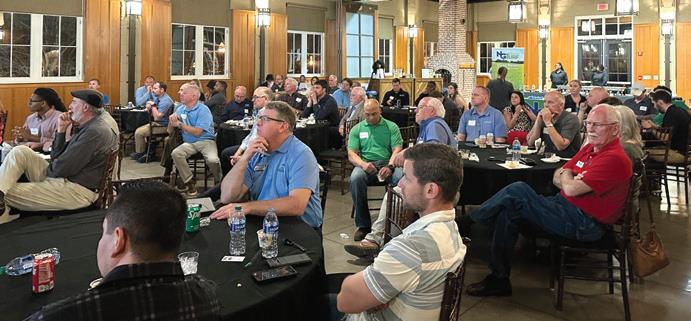




SPRING 2023 | 9 WHAT DID YOU MISS? “Theft and Crime” Networking Dinner | February 28 | Piedmont Park | Atlanta GA UAC NEWS
Herding cats and bringing order to chaos
Effective workflow management systems to streamline your business
Words of wisdom from Jenny Hardgrave, Simply Flowers, Inc.
Q. Help! It’s springtime and I’m feeling overwhelmed. How can I get a handle on all that I have to do?
I have cats. A lot of them. Yet, every night, I announce “bed time” and they come running from all over the house. Impossible? Not with a good system!
I have flower installations. A lot of them. Yet, every season, I announce “planting season” and we design, plan, install, invoice, and maintain annual gardens for over a thousand properties. Impossible? Not with a good system!
Let’s talk about creating systems that bring order to chaos… while minimizing errors, improving communications, and maximizing efficiency.
I cannot promise that your cats will behave after this, but your seasons will run just a little smoother. (P.S. A lot of these ideas can be implemented from your sofa with a cat in your lap. WIN-WIN!)
I started Simply Flowers more than 20 years ago. In my first year, I invoiced $28,000. I was so proud of myself. I prepped, planted and maintained all 12 of those jobs myself. I had a little help from my husband and my daddy for a few days. But mostly, it was me. I loaded the truck and cleaned the truck at the end of the day. I ordered flowers and paid the bills. I was basically a one-woman show.
These days, I invoice $28,000 before lunch. Simply Flowers installed 1064 jobs last spring. Most of that work was completed in the seven-week period between April 11 and May 26 with nine installation teams. I am the only designer. I also do all of the accounts payables, accounts receivables, payroll, and installation scheduling.
A lot of colleagues have asked me HOW we do it. To be honest, I love my job. I truly, truly love it. And I’m just a little bit crazy. It takes that balance of love and insanity to get through a flower season. But there are other truths of how systems can make things easier.
That’s what we’re going to talk about here.
If you want better results, then forget about setting goals. Focus on your systems instead.
You do not rise to the level of your goals. You fall to the level of your systems.
~ James Clear Atomic Habits
Fun fact about my background: I was a civil engineering major in college. During my junior year, I did a cooperative education program for a year with the Tennessee Valley Authority, at their research and development facility in Norris, TN. I lived in my parents’ RV at a campground with my cat. To say I hated that job would be an understatement. Truly, I hated that job. So much. The only things I really loved were the flower pots I planted all around my 8’ x 35’ motorhome, my cat, and my five-year old neighbor, who I taught to swim.
When my year was up, I kept the cat and changed my major.
But… I also kept the mind of an engineer. Systems, systems, SYSTEMS! I learned how to write FORTRAN programs. (Don’t ask me to do it now!) I mastered Excel concepts. I learned planning and discipline and data and protocols and organization. I learned the value of silence. I learned the importance of minimizing redundancy in data entries. Those lessons have served me well.
I also learned just how much I love flowers. It became an obsession. It’s all I wanted to do. And it still is.
Defining the system
> What do you do?
> What is the job?
> What are the steps involved?
I once outlined every step of our process, from the initial call from the client to installation to the first maintenance visit. There were 117 steps. That’s a lot of steps.
Then I went through that list and identified who took care of each step. Sales. Design. Production.
10 | UAC MAGAZINE ME & MY MENTOR
Then I looked for where there was redundancy. Is the same information being managed multiple times? How can that be minimized… or eliminated?
Scheduling a season
Break every task into manageable chunks.
1064 designs is too big to comprehend. Let’s call it 100 designs. Or irrigation audits. Or pine straw installations. Whatever it is that you do. Then you can scale the number to your needs.
You have how many weeks to complete the work? How many days a week will you commit to them?
Let’s assume 2 1/2 months = 10 weeks = 50 work days. That’s two designs a day. Does that sound more reasonable?
Here’s how to cut that number down even further: Do you actually NEED a design?
5% Clients trust your expertise (THE BEST CLIENTS EVER!!!!!)
Send ‘em a proposal and check it off the list!
3% Pots-only jobs
Don’t design pots. It’s a HUGE time suck. Train your install team on your signature container combos. Order those plants to keep on the lot. Boom. Pots done. For 100 jobs.
15% Repeat designs.
Seriously, do it. If you have years and years of designs in the archives, no one will remember something for four or five years ago. Review old service records: What worked? What didn’t? Tweak the design with new plant selections. (You know the growers change series EVERY YEAR!!)
15% Let clients select design from a limited set of pre-selected combinations
Don’t give them too many optionsanalysis paralysis will kick in. They will be overwhelmed and not make a decision at all! Works well for simple commercial jobs and residential clients.
15% Send plant combos for smaller jobs without actually drawing a design
Again, go to your pre-selected combos: Pick #1. Then pick #2. Then pick #3. Repeat. Over and over again.
LOOK! 53% of your design work is DONE! Now… to actually design the rest… Just 47 jobs to design!
Now you’re under one design per day. Finishing a design every day before lunch is realistic.
> Schedule it.
> Do it.
> Check it off the list!
Move on to the next task on the list ‘cause your system is WORKING!
Do you need a fancy design? Or an adequate design?
Crazy complicated drawings may be required on occasion, but not for every job. Be mindful of how you present a design the first time… clients WILL expect the same level of detail every season.
A design that is drawn to scale - is the client going to spend more money on this? It take sooo much effort to draw one of these! Or is it a very time-consuming exercise to boost your ego?
Scheduling an installation day
You have 100 jobs to install. Where to start?!?!? Going back to bed is NOT an option. Waving a magic wand will NOT work.
“You can only do one thing at a time and you can only do one thing first.”
~ My Mama
Eisenhower Decision Matrix
DO: urgent & important
This is where I start my day.
> If you plan well, this should be minimal and not high stress
> Do these first thing
> Invoice yesterday’s work
• Schedule tomorrow’s work
• Communicate schedules to staff, vendors, clients
• Pay stuff - bills, taxes, payroll
• Cash flow
PLAN: not urgent but important
This is where goals are met and fortunes are made. And it looks BORING from the outside…
> Designs - have them done before day 1 of installation = smoother season + more time to focus on daily stuff
> Training
> Data entry
> Set expectations
> Budgets
> Schedules
> Relationships
SPRING 2023 | 11 ME & MY MENTOR
1. 2.
DELEGATE: urgent but not important
This is where we spend most of our time… but shouldn’t.
These are things that may be outside of our control, but we have to face them. Other people bring us the crises of their own making.
We kind of love living in #3. It makes us feel important and busy. But these items do not move us towards meeting our goals & making money.
HR - the most irritating problem to me
> The job is easy. People are hard.
> Encourage positive communication.
> Discourage gossip. Set the example. If you do it, your staff will do it.
> Get involved when necessary.
> Make hard choices if required. Sometimes, it’s better to be understaffed than poorly staffed.
Client crises (aka BOMBS!) - defuse the situation
> You’ve experienced this scenario:
You have a beautiful plan. It’s perfect. Everything fits. Every need is met. The routing is perfect. You’ve told folks you’re coming. All of the paperwork is done. The orders are placed.
And that call comes. Probably at 10:47 am, right after you were so proud that everything for tomorrow is set in motion.
There’s a VIP visit that the manager forgot about. There’s a party. There are guests coming. There’s an investor meeting. There’s a wedding that just came up. (I’ve actually had that call!) Whatever the crisis is, it just blew a hole in your plans.
You have to make this installation happen. And you are SUPER angry that the client was so inconsiderate as to give you a mere 21 hours and 13 minutes’ notice. Really, you feel like there is no notice because you are required to have orders finalized by 9:30 AM and it’s already past that. And you did your part. And you did it well, DANG IT!
> Give yourself time and space to find a solution. Tell the client that you understand their request. You need a little time to figure this out for them.
> Your urgency and emotions do not have to match theirs.
> Let’s face reality. You can talk about it… or you can take action.
> Get off the phone and work the problem.
> Don’t go down the hall to complain about how inconsiderate the client is. Don’t fan the flames by calling your coworkers to fuss about how upset you are. Don’t call the vendor and tell them how your client is a great big jerk.
NONE OF THIS HELPS SOLVE THE PROBLEM!!!
It just escalates your emotions, wastes your time, wastes others’ time, and delays the solution. Emotions don’t solve the problem; systems do!
You can help the most when you are calm, cool and collected.
Focus on what you CAN do, not what you CAN’T.
> Where is the job?
> How big is it?
> Does this client have another job in the same area that can be traded for it?
> Is another team going to finish early today that can prep it? Or even plant it?
> Is there someone on tomorrow’s list who can wait?
> Can a team work a little later tomorrow and add this site?
> In 53 seasons of doing this job, there are just a few occasions where I’ve actually said NO. You can almost always find an answer.
Emails, texts, phone calls
> Can you outsource any of this?
> Answering service.
> Assistant for emails and returning calls.
> Assistant responds to client and creates work orders for minor concerns.
> Only important emails get to me… maybe 6-12 daily.
Batch tasks
> Imagine this: you have three things that each take 30 minutes - professional conference call, take a swim, go to the grocery store.
But all of that anger and aggravation does not change one fact: this installation has to get done. So…
> You would do each of these tasks all at once, right? But imagine if you didn’t. What if you did them five minutes at a time? What would that look like?
12 | UAC MAGAZINE ME & MY MENTOR
3.
With all the things that could go wrong with your natural grass crop, isn’t it nice to know that a Progressive Turf Equipment™ mower isn’t the biggest part of your headache? In fact, we at Progressive have worked hard over the past 30 years to bring to the market a Quality built product that just happens to cut grass second to none. These low-maintenance mowers coupled with inventory parts that interchange, provide instant cost savings that will affect your bottom-line year after year.



Feel free to go on-line or call your Progressive Dealer now to find out how Progressive mowers will add to your bottom line AND why a Progressive Turf mower will help you cut grass and not profits.


SPRING 2023 | 13
WWW.PROGRESSIVETURFEQUIP.COM
TD-92™
TDR-30™
TDR-26™
Quality
in North America and supported by a world-wide Dealer network.
grass, not your
TDR-22™
800.668.8873
built
Cut
profits
Pro-Max 36™ shown
> Swim for 5 minutes.
> Come inside. Change clothes. Dry hair. Reapply makeup.
> Get on conference call for 5 minutes.
> Get in the car.
> Drive for 10 minutes.
> Go to the store.
> Shop for 5 minutes.
> Check out.
> Drive home for 10 minutes.
> Change clothes.
> Head back to the pool. Repeat the cycle. 6 times.
Ridiculous, right?!?!
All three tasks could have been completed in under two hours if they had been batched. By splitting each task into five-minute segments, you’ve spent almost six hours doing the same amount of actual work!
This is precisely how the brain works. If you are deep into a task and get interrupted, it can take up to 15 minutes to reset your mind back into the flow of your original task. 90 minutes of actual work took six hours… because of interruptions or poor planning.
Instead, plan to do your daily tasks in a series of uninterrupted batches. Also, plan time for managing the disruptions. Coworkers WILL need your attention. Phone calls WILL have to be returned. Bombs WILL have to be defused. But put them on YOUR schedule to maximize your day.
Limit phone calls, office drop-ins and meetings.
> Talking makes us feel busy.
> Talking connects us to other people. That feels good.
> Talking gives us an outlet to gossip about our stuff.
> But… talking is not producing.
> Negative chatter is a toxic time killer.
> Sometimes, I have to tell myself: Jenny, shut up and get to work!
Text communication is GREAT.
> It’s hard to write a long text, unless you have a keyboard on your iPad. The same is true for your counterpart. Quick initiation. Quick response. Get on with your day.
Set aside time for email batching
Cancel notifications on emails, especially on your phone/mobile device.
> Seriously, the interruptions rob your time and sanity and productivity.
> The most important person you can talk to is the one standing in front of you; give him/her your full attention!
> Email bombs interfere with productivity. Refer back to the scenario of swim-conference call-grocery store. You would NEVER manage your day like that, right? So… don’t allow your day to manage YOU like that!
Vendors
> Late for delivery
> Outside your control
> Again, systems help. We talked about pots earlier. We make a bulk order and pull these from the shop each morning. Our staff has something to do until the flowers arrive.
> Prep.
> Move mulch close to the beds.
> Help another team that’s close by.
> Substitutions that weren’t authorized
~
He Can Who Thinks He Can, 1908
Examples of tasks that should be done in batches:
> Answer all emails
> Send all invoices
> Order all flowers
> Process all paperwork
> Pay all bills
> Schedule work
Otherwise, you’re playing tennis and hitting every ball as it comes. NOT EFFICIENT… and it’s EXHAUSTING.
> Be open-minded. Can Punch Vinca work just as well as Hotgenta Vinca? Can Little Lucky Pot of Gold Lantana work in place of New Gold Lantana? If so, roll on!
> If the sub just doesn’t work, make a phone call. Be polite. Be generous. Your vendor is your PARTNER, not your enemy. They want you to succeed, too. Your success equals their success. Emotions don’t solve problems!
> Missing plants
> When can the vendor send out the corrections?
> Can a manager pull from inventory? Or pick up plants for the team?
14 | UAC MAGAZINE
“People do not realize the immense value of utilizing spare minutes.”
Orison Swett Marden
ME & MY MENTOR
> Can you use flowers that were scheduled for another job?
> TEAMS SHOULD STAY ON SITE! Let the corrections come to them!
> Focus on what you CAN do… not what you CAN’T.
> Whatever job you are standing on is THE MOST IMPORTANT JOB. Finish it before moving to the next site.
ELIMINATE: not urgent, not important Oh! How much time we waste in this box!
> Social media
> Gossip
> Gaming
> TV
> Focusing on how tired you are
> Negative emotions

Identify the things in your life and work that do not have a significant return. Eliminate them.
> Be consistent
> Evaluate the system



> Tweak and improve as growth occurs

> Embrace technology
> Always be learning and growing
> Constant improvement
> Start where you are
> Use the skills you already have
> Look for others who can help move you forward
Embrace technology: When the fax machine fell out of favor, our grower implemented online ordering. It is a very handy and efficient system for folks with just a few orders per day. For me, it was too much.
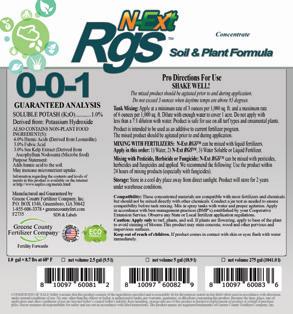


If each entry took 10 minutes (to enter address, delivery instructions, and go through hundreds of line items to put flat counts by each), it would currently take more than seven hours to enter jobs for one day. That is not an option for me or the grower.

So… we invited the systems people from our grower to come and look at our system. We found a way to make our systems talk to each other. Now, the process takes the grower about 20 minutes. It takes us about two hours, but it also includes ALL of the paperwork for the crews as well. Win- win.
Constant improvement: We started with 12 accounts. I could keep up with those in my head.
Every season, we grew. It got more complicated. My head got full. We needed a new system.
The Post-It Note calendar was next. Every job had a Post-It Note. We ran a mail merge program to create clear labels for each Post-It Note. It included the ft² and pot count. They were all stuck the walls in our office hallway.
As clients approved, we put a foil star on the Post-It. We also added any special instructions, like deadlines for special events.
Then we could start moving them around. We work as a sub, so each contractor had its own color. I made long lines of schedules by date. It was handy to see that we had a even distribution of colors.
As the jobs were completed, a date was put on them.
After they were invoiced, a big check mark was put across them.
SPRING 2023 | 15 15 UAC MAGAZINE |SUMMER 2022
ME & MY MENTOR POWER UP YOUR SOIL GreeneCountyFert.com Fertility Forward® High Performance Plant Nutrients Fertilizers ▪ Specialty Products Soil Amendments ▪ Custom Blends BUY/SHIP DIRECT LOCAL PICK-UP
MAXIMIZE YOUR FERTILIZER EFFICIENCY Corp. HQ/MFR: Greene County Fertilizer Company 1490 Airport Rd., Greensboro, GA 30642 Fertilizer MFR ▪ Distributor of Chemical L&O pest control products
Our bio-based fertilizers & specialty fertility products are blended to feed plants, improve soil fertility and build topsoil.
4.
A very primitive system, but very effective. Anyone can do it without any specialized computer skills. It’s visual. It’s easy to manipulate. It’s easy to control.
Until there are too many of them. Then a computer has to be involved.
I adapted Excel to do the same things my Post-It Notes were doing. We grow. We adapt. We evaluate. We improve. We continue to improve every season.
How does one schedule over 1200 jobs?
Let’s think of it as a jigsaw puzzle. Everything WILL eventually fit together to form a complete picture. But in the beginning, it’s just a bunch of jumbled pieces in a box. HOW do you start?!??
Most folks will start by sorting the pieces. So do I. Yes, I look for the straight edges. But I also sort by color. And pattern. And when I find the corner pieces, it’s like finding gold.
Sorting your schedule should follow a similar process. There are only four corner pieces. What are your cornerstone jobs? I don’t have to explain this; you know what they are.
Put those in place and build from there.
REMEMBER: EVERY PIECE IS IMPORTANT. That’s why it’s in the box. Don’t dismiss any client as unimportant. Some ARE harder to find a place for. Sometimes they all look similar. (Think big blue sky pieces.) But without every piece, your picture is incomplete.
TRUTH: You can’t complete a 1200 piece puzzle in an hour. It’s time to revisit these wise words:
“You can only do one thing at a time and you can only do one thing first.”
~ My Mama
> Start with one piece at a time.
> See how the pieces fit.
> Try to knock out large chunks at a time. Again, we go back to batching. Remember how much you got done in the office with batching tasks? You can have similar efficiency in batching installations.
> The grower LOVES it.
> They save fuel and time.
> One truck delivers everything in an area.
> They get their driver back quickly to reload for tomorrow. And YES, you SHOULD be concerned with how your schedule affects other players. If you help reduce costs to your vendor, they can keep their prices lower, too.
> By having all of your jobs close together, you can dominate the delivery truck.
> Imagine being drop #1, 2, 3, AND 4 for the day!!!
> It’s easier to schedule.
> Teams finish earlier when flowers arrive earlier.
> Simplifies decisions for you.
> Creates synergy.
> If one team finishes early, they can help another team in the area.
> If equipment breaks down, teams can borrow from another group.
> If something is wrong on one delivery, teams can stay busy helping at another site.
Here’s a little catch to our jigsaw puzzle concept… each piece is actually comprised of a lot of other tiny pieces. Lots of these sub-pieces are outside of our control.
> Deliveries/vendors/orders
> Plant availability/size
> Traffic
> Staffing
> Designs
> Schedules
> Expectations
> Weather
> Irrigation
> Wildlife
> Mulch infested with weed seeds
When things go wrong… BE KIND.
Earlier we talked about bombs.
> Last-minute client emergencies
> Staffing shortages
> Weather
> Traffic
> Grower shortages & wrong orders
Bombs happen. Accept this as a truth. They are coming.
> Your beautiful plan to assemble your puzzle today just exploded.
> The pieces of your puzzle change shape. They no longer fit the same way.
> You need a new plan.
16 | UAC MAGAZINE ME & MY MENTOR
REMEMBER: Attitude is a choice.
I was in a little breakfast dive in Savannah not long ago. My order wasn’t right. It happens. I asked the server for the grits I ordered. She argued with me about what I ordered. She also got into a fight with another waitress about a missing tip. The whole restaurant heard it. It was awkward.
The food was amazing… especially those grits. But I’m not going back. No food is good enough to sit through another uncomfortable meal.
On the other hand, a couple of young ladies were working in a really sweaty little ice cream shop. They smiled. They were pleasant to everyone who came in. They were patient with the questions of every tourist on Tybee Island. They scooped ice cream while the sweat ran down their very red, happy faces.
And you know what? Everyone I saw put a $5 tip in their jar. Their attitudes made all the difference. They will have repeat business.
So…choose the right attitude:
Choose to be kind. Everyone is doing the best they can. Most of them are short-staffed, just like you.
> Choose to find solutions.
> Choose to be generous.
> Choose to be helpful.
Negative emotions drain your energy. They slow down other people on your team. They make your vendor dread your calls. They put your clients off.
Even when things go wrong, your attitude can make all the difference. Try this the next time something goes awry with a delivery:
Good morning, Gary! I need your help, please…
See if it makes a difference.
Jenny Hardgrave | Owner, Simply Flowers, Inc.


When Jenny Hardgrave started Simply Flowers in 2001 she had $10 in her pocket and a dozen clients. She had already cut her teeth in the horticulture world as a seasonal color designer and production manager for a prominent Atlanta landscape company. This Tennessee native grew up in a family of entrepreneurs; she was willing to work hard and take chances. Her dream was to launch her own business – one that would concentrate solely on seasonal color. So with a box truck given to her by her father and an F-150 nicknamed Diva, Jenny and her small staff started changing Atlanta’s floral landscape.
Simply Flowers has a reputation for unique designs, quality flowers and outstanding customer service. Since 2002 Jenny has been the recipient of numerous awards for her exceptional garden designs and installations.
UAC business-level members can select the auto-recurring payment option for their annual membership investment and get an immediate 5% discount.
The auto-recurring payment option is available for credit card payments only. Your credit card automatically will be charged on your annual renewal date.
It's easy: First, go to urbanagcouncil.com > Choose the Membership menu, then Member Login. NOTE: Only the primary contact for your company will be able to manage/renew the company's membership. Contact us via phone or email if you need help with logging in.
Even easier: Contact us and we'll do it for you! Call 706.750.0350 or email office@georgiauac.com
SPRING 2023 | 17 ME & MY MENTOR
The easiest 5% you'll ever save. Sign up for auto-renew now!
Have you met...
Tomeco Farrior Savannahs Landscaping Services


My first job in the green industry was...mowing lawns.
My biggest challenge in my career has been… managing employees.
The people who have most influenced my career are…. everyone I have come into contact with for longer than five minutes.
My biggest career success so far has been…. building a sustainable company.
If I had it to do over again, I would…..have invested in a website before I ever bought any equipment.
The thing I like most about my career is…. you can tailor it to the lifestyle you wish to live.
My least favorite part of my job is…paperwork. One piece of advice I would give to someone entering the green industry today is…always do quality work.
The one thing most responsible for my success is…not accepting failure as an option.
If I could change careers, just for a month, I would…become a pilot.
One thing that really annoys me is…telemarketers using cold calling to sell me SEO.
When I’m not working, I like to…spend time with my two boys, teaching them how to work.
Contact info: Address: 5710 Ogeechee Road Savannah GA 31419
Phone: 912-386-1232
Email: t.farrior@gmail.com Web: savannahslandscapingservices.com

18 | UAC MAGAZINE
HAVE YOU MET
Recently completed sod Installation.
Springtime in the Courtyard Dinner
SPEAKER: Michael Jackson, Michael Jackson Landscape Company
DATE: Tuesday, April 11
PLACE: Topiary Courtyard
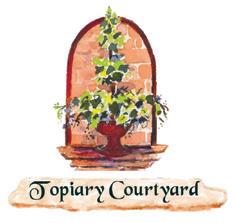
3045 Jones Mill Road | Peachtree Corners GA 30071
Sponsored
APR
You’ll have a chance to explore the nursery before the dinner and place orders –and receive 10% discount if purchased that evening for later delivery!
Peek into the future of your industry


Meet the students, see what they're learning
DATE: Thursday, May 4
PLACE: Chattahoochee Tech
980 S Cobb Drive SE, Marietta GA 30060

WORKSHOP: Get a grip on your business
DATE: Thursday, June 8
PLACE: Snellings Walters Insurance Company

1117 Perimeter Ctr W, Ste W101 Atlanta GA 30338
Brian Sulka from EOS Worldwide provides a perspective of helping over 15,000 businesses break through challenges that are limiting their growth, scalability, and profitability.
In this 90-minute workshop you will learn to strengthen your business using proven tools. You will walk out with ideas that you can take back into your business and immediately see change. You will also get copy of the book Traction. Lunch is included.

NEW! Vendor/industry exhibitor and demo event
DATE: To be advised
PLACE: NG Turf | Douglasville, GA
Stay tuned for details!
UAC Sporting Clays Tournament

DATE: Thursday, October 26
PLACE: Blalock Lakes | 4075 New Corinth Road | Newnan GA 30263
Stay tuned for details!
UAC Georgia Sod Producers Field Day



DATE: Tuesday, November 7
PLACE: Super-Sod | Ft. Valley GA
Stay tuned for details!
MAY 4
SPRING 2023 | 19 Visit urbanagcouncil.com for updates and to register. SAVE THE DATE
11
TBA
SEP
URBAN AG GEORGIA COUNCIL
OCT 26
NOV 7
8
JUN
by
Juniper scale
A common scale insect in nurseries and landscapes

 by Shimat V. Joseph, Associate Professor, University of Georgia Department of Entomology
by Shimat V. Joseph, Associate Professor, University of Georgia Department of Entomology
The juniper scale, Carulaspic juniperi (Fig. 1.) is a sporadic pest of junipers, cypresses, and cedars in nurseries and landscapes in Georgia. Native to Europe, the juniper scale is now widespread in the eastern US. The juniper scale is an armored scale where the wax cover is not glued or attached to the insect body but rather can be separated from the insect body.
The juniper scale feeds on plant fluid by piercing and sucking mouthparts. This scale pest settles on the needles of the conifers. With heavy infestation, the plant vigor can be reduced, causing needle drop and twig color to change from green to brown, making the plant appear unhealthy.
Description and biology
The covers of the female scale are circular, white, and about 1/16 inch in diameter (Fig. 2). The immature males are smaller, white, and elongated (Fig. 2). The shed skin from the scale body is incorporated into the cover, and it appears yellow-colored. Adult females overwinter on the needles. In the spring, a female produces about 40 eggs. These eggs hatch within two weeks, and yellow crawlers are present in the late spring. The crawlers are dispersed by wind or birds to neighboring trees. The crawlers settle by inserting their hair-like mouthparts and molt into immobile nymphs. The female scales have three nymphal stages, whereas males have five. The winged adult males lack mouthparts and die immediately after mating. They undergo one generation per year.
Damage
The scales colonize the needles of the hosts. The affected plants lose plant vigor and rarely produce new growth. The new growth, if present, will not be evenly distributed, and the tree appears stunted. Yellowing and dieback of needles are common symptoms and are clearly evident after infestation (Figs. 3 and 4). Similar to other armored scales, the juniper scale does not produce honeydew.
Host range
This armored-scale insect attacks various types of junipers, such as pfitzer juniper, Irish juniper, savin juniper, and Chinese juniper. The juniper scale occasionally becomes a problem in landscapes and nurseries. They can infest and survive on Leyland cypress, false cypress, arborvitae, cryptomeria, incense cedar, and eastern red cedar.
20 | UAC MAGAZINE PEST 411
Fig. 1. Juniper scale (Female).
United States National Collection of Scale Insects Photographs, USDA Agricultural Research Service, Bugwood.org
Fig. 2. Juniper scale (Female, black dotted arrow; Male, solid white arrow).
Lorraine Graney, Bartlett Tree Experts, Bugwood.org
Management
Insects generally thrive on stressed plants, and the juniper scale is no different. In nurseries, scales can easily find many hosts, many of the same species. Proper irrigation and timely and adequate fertilizer application will reduce tree stress. As part of cultural management, the densities of scales can be reduced by pruning the severely infested twigs. A few tiny parasitic wasps and ladybugs were reported from the juniper scale, but the impact of these biological control agents is not studied thoroughly.
The application of dormant oil spray in the winter can cause substantial adult mortality as they overwinter as adults.
Contact insecticides are effective if used for the crawler stage of the juniper scale. The crawlers are produced during the late spring (in May).


Still, it is critical to accurately determine the initial crawler activity to time the application of contact insecticides for effective management. Double-sided sticky tape or electric tape with the sticky side facing out can be used to monitor crawler emergence. The crawlers will be caught on the edge of the tape, indicating crawler emergence. The tapes should be visually observed at regular intervals.
Contact insecticides, such as horticultural oil or insecticidal soap, target crawlers. The concentration of horticultural oil or insecticidal soap should be about 1% because higher doses can be sensitive to host trees, causing phytotoxicity.

The residues of horticultural oil and soap will break down quickly in the environment and are considered an organic management approach. Synthetic pyrethroids, permethrin, bifenthrin, lambda-cyhalothrin, deltamethrin, and cypermethrin are more persistent contact insecticides. Contact insecticide application on female juniper scales is ineffective because they are protected from the thick waxy cover.
When a severe infestation occurs, systemic insecticides, such as dinotefuran, can be used in the fall and spring as a soil drench or granular application. If a systemic insecticide is chosen, the application of contact insecticide can be avoided. Please carefully read the insecticide label because the label is the law. After application, the tree’s health should improve with new growth vigorously appearing with standard color.
SPRING 2023 | 21 PEST 411
Fig. 3. Damage from juniper scale infestation.
Joseph LaForest, University of Georgia, Bugwood.org
Fig. 4. Juniper scale infestation in the residential landscape.
Joseph LaForest, University of Georgia, Bugwood.org
Employee benefits
The issues at hand and solutions within reach
by Tara Byrd, CIC, Employee Benefits Consultants, Snellings Walters Insurance Agency

Choosing the best employee benefits package can feel complicated, stressful, and confusing, but it doesn’t have to.
Here are the issues companies face and solutions within reach when it comes to employee benefits:
67% of employees don’t believe that their organization understands which rewards are relevant to their needs.
33% of employees don’t understand their employee benefits communication.
55% of employees wish they were more informed about their benefits so they could get more value from them.
The above statistics are the real issues at hand when it comes to shopping for employee benefits carriers.
The bottom line is you are paying to provide benefits that employees don’t understand and don’t get the full value.
So, if you are:
4 4 4 4
Ready to align your employees’ needs with your business’s needs;
Tired of shopping different carriers for better rates; Losing top candidates due to high costs or inadequate benefits; and
Frustrated with the lack of transparency or understanding of your benefits;
...then it’s time to start thinking about your employee benefits differently.
Take a step back
So, where do you go from here to achieve actionable results?
First, stop shopping for the cheapest rates. Take a step back and evaluate your current benefits process. Here are a few questions to ask yourself, then give yourself a letter grade:
As a business leader, how would you grade your current understanding of your business goals?
c A c B c C c D c F
Now, how would you grade your current understanding of how your benefits align with those goals?
c A c B c C c D c F
Lastly, if you were to ask your employees, how would they grade you on the job you are doing with your employee benefits?
c A c B c C c D c F
If you answered below a B on any of those questions, it’s time to make a change. If you need help creating an employee benefits package that will leave your employees thanking you, help you reach your business goals, and save you money, we’d love to help.
About the author
Tara Byrd, CIC, is an Employee Benefits Consultant with Snellings Walters.


E: tbyrd@snellingswalters.com
P: 770-268-3688
W: snellingswalters.com
22 | UAC MAGAZINE HEALTH & BENEFITS
URBAN AG GEORGIA COUNCIL
Snellings Walters is the official insurance partner of the Georgia Urban Ag Council.
Safety is good business
The costs of an unsafe workplace
by Ellen Bauske, University of Georgia (retired)
Do you ever wonder if safety is worth it? We know PPE costs money, safe procedures may take a little more time, and you can’t bill for safety training time. We all know and understand the human cost, but we don’t worry about it because we think it won’t happen to us. Even a single injury can have far-reaching and debilitating effects on your business.
OSHA has created $afety Pays to assess the impact of occupational injuries and illnesses on business profitability.
Employers can use the Safety Pays Individual Injury Estimator to assess the impact of occupational injuries and illnesses on their profitability.
This program uses a company’s profit margin, the average costs of an injury or illness, and an indirect cost multiplier to project the amount of sales a company would need to generate to cover those costs.
The program is intended as a tool to raise awareness of how occupational injuries and illnesses can impact a company’s profitability, not to provide a detailed analysis of a particular company’s occupational injury and illness costs.
Your local OSHA On-site Consultation Office can help small businesses identify workplace hazards and develop and implement an effective injury and illness prevention program.
The program is easy to use and the website clearly explains the methodology and assumptions. You just need to put in: injury type (or workers’ compensation costs), your company profit margin (the default is 3%), and the number of injuries.
The bottom line: it gets ugly fast. Lose a finger, fall and break a bone, get hit on the head – these are all things that happen in your work.
This is what $afety Pays calculated for a few injuries:
Amputation Direct Costs = $77,995

Indirect Costs = $85,794
Fracture Direct Costs = $50,778
Indirect Costs = $55,855
Contusion Direct Costs = $27,511
Indirect Costs = $30,262
The employer always pays the indirect costs. The extent to which the employer pays the direct costs depends on the nature of the employer’s workers’ compensation insurance policy.
If a worker is injured on the job, it costs your company in lost work hours, increased insurance rates, workers’ compensation premiums, and possible litigation. Productivity is lost when other workers have to stop work to deal with the injury. Even after the injured employee has been sent home or taken to the hospital, other employees may be distracted or need to take time off from work in the aftermath of the incident.
A serious workplace injury or death changes lives forever – for families, friends, communities, and coworkers. In our industry occupational injuries and illnesses can provoke major crises for the families in which they occur. In addition to major financial burdens, they can impose substantial time demands on uninjured family members. Every person who leaves for work in the morning should expect to return home at night in good health — that is the most important reason to create a safe and healthy work environment. But it isn’t the only reason. Safety training and PPE saves lives and money. Check out $afety Pays: osha.gov/dcsp/smallbusiness/safetypays/estimator. html.
SPRING 2023 | 23 SAVE THE DATE SAFETY WORKS
Even a single injury can have far-reaching and debilitating effects on your business.
Search Engine Optimization
How much does SEO cost?
by James Yorgason for Manta
To get a better understanding of how much does SEO cost , let’s break down each pricing model.
Want to improve your website’s online visibility? Wondering how much does SEO cost for a small business? Prices for a marketing agency or an SEO specialist can vary. As a small business with a limited budget, it’s important to know how much SEO costs before you sign a contract or hire a consultant.
What is SEO?
Organic SEO (search engine optimization) is the process in which a website is created and optimized in an effort to rank higher on search engines for valuable keywords. The goal of SEO is to increase qualified website traffic and conversions from target keywords relating to your products or services.
Common activities include keyword research, white hat link building, local SEO, and SEO content services to name a few. It’s a process that can take months to show a return on investment. But when that day eventually comes, SEO is the most cost-effective digital marketing channel for the entire company.
How much foes SEO cost?
Search Engine Journal released a 2022 SEO Agency Report that found that most businesses spend between a range of $500 to $10,000 a month on SEO efforts. The average rate for SEO services in the United States is approximately $147 an hour.

4 4 4
Hourly ($50 – $200+ per hour)
Hiring by the hour can be an expensive proposition depending on the work that needs to be done. This figure might even be a little low if you’re working with an agency that is well known or has extensive experience. Depending on the type of work that needs to be done, you may consider contracting with an organic SEO company to optimize your website properly. Results may be slower to achieve with this type of agreement if there is a cap set to the hourly agreement.
Project based
($1,500 – $5,000+)
Many resources out there suggest that these prices start at $1,500, and can go up $5,000+. The starting point is accurate, as the agency needs the price to be healthy enough to still be worth it.
The top end, however, is going to vary significantly based on the actual work being done. If an agency or consultant tries to pitch you on a large project-based price (that’s not a website redesign), ask for a monthly billing arrangement instead.
Examples of this type of pricing typically includes the following:
> Technical SEO audit
> Technical SEO fixes (i.e. redirect clean up, URL structure updates, mega menu/navigation hierarchy setup)
> Site migrations
> Content optimization projects (set number of pages)
> And more!
Basic local SEO
($250 – $500+ per month)
When it comes to local SEO for basic packages, it can typically be less expensive. Basic SEO pricing usually covers areas such as:
> Basic research
> Keyword analysis
> Optimized titles and descriptions
> Content optimization
24 | UAC MAGAZINE WHAT THE TECH?
> Submitting to directories
> Monthly reporting and backlink analysis
Ultimately, pricing depends on the company’s goals and available budget. However taking advantage of smallscale local SEO is definitely worth consideration.
Comprehensive Local SEO
($600 – $4,000+ per month)
This campaign typically offers more in-depth options covering aspects of SEO such as:
> Local Business Citations
> Directory Development
> Keyword Strategy
> Content Creation
> On-site, Off-Site, and Technical Optimizations
> Authority Link Building
> And more!
Local SEO packages will increase with more comprehensive services. However, they are detailed marketing campaigns that offer great value and higher returns.
4 factors that impact price
As with any service that isn’t regulated, nor is an exact science, the pricing can vary depending several factors:
Competition level
With competition in an industry, SEO strategies need to accommodate. In a less competitive market, simpler and/or fewer tactics may be required due to fewer players in the game, making it easier and more cost effective to rank for desired keywords. However, if an industry is highly competitive then budgeting for SEO is key.
A greater number of tactics may be required with longer timelines since resources will have to be invested for the long-term return on investment. More investment typically translates into greater keyword difficulty. This is because there are more websites vying for top rankings within search engine result pages (SERPS).
This doesn’t mean that it can’t be done, but there is definitely higher cost involved with high competition and that should be kept in mind along with any timeline goals set when formulating an SEO strategy.
Complexity of the industry
The complexity of the industry can be a major factor in the cost of search engine optimization (SEO). If a business is looking to work with an agency, SEO professionals will need to invest time in learning about
the industry, business operations, and more. By doing this it helps to successfully market a website, products or services, and optimize for SEO. This may incur additional costs for the business that would go beyond the hourly budget already allocated.
To make sure you are getting your money’s worth, it’s best practice to ask an agency about their experience level and request case studies so you can be confident they have an understanding of your industry. Doing so can help save your business money down the line while ensuring you get quality results.
Amount of work needed
This factor refers to the amount of SEO work that is needed to be done to your website. Be reflective and ask your business these questions:
> Is your SEO relatively small scale or is it extensive?
> How much backlinking is required?
> How much content needs to be optimized and created?
> Is this the first time SEO is being conducted or are they in updating mode?
> Is the site looking for a maintenance role on the website instead of intense growth?
Conducting a site audit will help uncover any areas of opportunity. Additionally, an in-depth competitive audit will identify new opportunities to pursue once the existing items have been brought up to standard.
Here are a few strategies and avenues to consider when looking at the amount of SEO work that’s needed to be done:
Content optimization
Content optimization (or on-page SEO) is considered a critical first step in an SEO strategy. As a small business, you may not have much content on your website. Content creation and optimization is all about optimizing existing content and building more effective content that will rank higher on search engines.
Optimized content is not the only ranking factor but is a great place to start. It should cover fundamental SEO best practices and will make a significant impact.
Technical SEO
Technical SEO refers to improving the technical aspects of a website to improve search rankings. Search engine algorithms not only pick up on content, but other factors such as mobile friendliness, site speed, and more.
Instead of taking hours to learn about each of these factors, hiring an SEO company can save you much needed time. You could pay for technical SEO projects on
SPRING 2023 | 25 WHAT THE TECH?
1. 2.
4
3.
a one-time basis or as an ongoing process depending on the task. It’s best to make sure your website is running at full capacity.
Link Building
Creating backlinks (or link building) plays a crucial role in any SEO strategy. Search engines highly favor websites that other websites point back to them with a link. Some links happen naturally on your site as you create quality content.
If you are looking to rank more quickly, outsourcing your SEO strategy for backlinks to a link building agency can help save you time and money. It’s best to build quality backlinks month over month to show search engines consistency and authority.
Local SEO
If you have a local business, or looking to promote your business in a specific geographic area, affordable local SEO services can help get the job done. Local SEO can help you rank for target keywords in a specific area. It’s an affordable and effective way to improve your visibility within a town or city. Another effective technique and strategy is being added and handling listings management.
SEO provider types
The way you conduct your SEO optimizations can be done in several ways. Here are a few SEO provider types your business can consider when it comes to determining the final price for SEO.
In-house SEO specialist
According to Salary.com, the average salary for an SEO specialist in the United states is around $46,000 per year in 2022. The salary range falls between $42,995 and $52,042 on the high end.
Although it can prove profitable, this is often a more costly approach for many businesses. Especially for small businesses.
SEO agency
An SEO agency is a business that specializes in optimizing websites to increase their visibility in search engine rankings. Their primary goal is to make sure that the website appears as high up on the search engine results page (SERP) as possible.
When it comes to determining the cost of SEO services, factors such as the target market size, competition level, quality of the agency’s services and other associated costs must be taken into consideration.
By analyzing these key elements and working together with an experienced SEO agency, businesses can ensure
that each dollar spent yields maximum returns in terms of increased online presence and better customer conversion rates.
SEO consultant
An SEO consultant is a professional expert that specializes in improving a website’s visibility on search engines. Through various techniques, such as optimizing a website’s content and structure, they strive to get relevant pages to rank higher in SERP rankings. This can result in more traffic for the website and increased lead generation; both of which are crucial for online businesses.
Depending on the size of the website and other factors, determining an SEO consultant’s price can vary significantly. They will typically look at things such as how competitive the industry is for SEO, how much work is involved in optimizing the website, how lengthy their services will be and so forth.
Freelancer
SEO freelancers typically analyze websites and suggest upgrades for better rankings within a search engine’s algorithm. This may include SEO elements such as title tags, site speed, keyword research, and content creation and optimization. All of these activities require time and effort from an SEO freelancer in order to provide a successful outcome for their clients.
Part of determining the price for SEO efforts includes accounting for the amount of work that will be required. As well as evaluating competitiveness within the same industry. If multiple businesses are competing for similar keywords, that would require more effort from the SEO specialist.
Ultimately, an experienced freelancer with expertise in SEO will be able to evaluate how much time they must put into creating and implementing strategies that will move a website up on SERPs.
FAQ about SEO
QHow much should you spend on SEO?
The CMO Survey released a report that shows businesses typically allocate 8% to 13% of the company’s revenue to the SEO budget. For small businesses, this may not be a realistic budget.
The more competitive the industry and area, the higher the cost. Local SEO campaigns in small towns or cities will have much less competition – meaning a lower cost. Ultimately, how much you spend on SEO should strike a balance between the SEO needs, competition, and what your business can afford.
26 | UAC MAGAZINE
WHAT THE TECH?
4.
You should not jeopardize the financial security of your business for the sake of marketing.
Use our free SEO analysis to determine your website’s SEO health. After you fill out the form, a digital marketing professional can reach out to provide a more accurate estimate on your recommended spend level.
How long does it take to see results from SEO?
Generally, it takes 6-12 months to see results from an SEO campaign. Once you reach the top 10 results in a SERP, it takes time and work to maintain your rankings and consistently improve your strategy.
As rankings improve, you will see an uptick in relevant organic traffic. Proper conversion rate optimization will also increase the number of leads and conversions. Along with your spend level, results will depend on the amount of competition you encounter.
Is SEO worth It for small businesses?
Yes, SEO is more of a long-term strategy in comparison to PPC and other digital marketing services. However, the results and ROI of SEO can bring huge long-term results.
If you want to appear and remain in the top 10 results on search engines, SEO is a great option. Although there is a higher cost upfront, SEO is a great way to generate more leads and revenue for your business at a lower price.
About the author
James Yorgason was a part of the SEO Client Services Team at Boostability for five years, and has since transitioned to a Sr. Manager position of the Digital Campaign Success Team for Manta. He has a BA in Business Management. He has a passion for helping customers have a great experience, and loves seeing their small business grow. When he is not working with our customers, he can be found disc golfing, or looking for some fresh snow to snowmobile in.
About Manta
Manta is one of the largest online resources dedicated to small business. We deliver products, services and educational opportunities that are effective, easy to understand and geared to help business owners become more competitive in their respective industries. Learn more at manta.com/resources

SPRING 2023 | 27
WHAT THE TECH?
Q Q
Taking control Organization techniques to manage demanding workloads
by Erin Saunders, Leica Geosystems
When things get busy, it can feel overwhelming. There are multiple competing priorities coming at us from emails, texts, phone calls, meetings, and tasks. But there are things we can do to organize our space, use planning tools effectively, and manage email to help organize our time and stress.
Planning
One of the first things we can do is plan our day. If you’re like most people, you can actually save yourself an hour a day by getting more organized.
One essential tool is an up-to-date calendar. Your calendar can be your most effective planning tool.
Any task that takes longer than five or ten minutes should be put on your calendar according to priority.

Similarly, ask your colleagues to set time with you on your calendar.
There is little more stressful or exhausting than back-toback meetings. If you’ve blocked off time for projects and tasks, having time for meeting with others becomes much less stressful.
Jumping in
Another barrier to productivity is procrastination. Mark Twain had a saying that, “if you have to eat two frogs, eat the ugliest first.” In other words, take the ugliest frog in your day - the thing you are most dreading or procrastinating - and tackle it early in your day.
That thing you’re putting off often becomes bigger and more daunting than it really is.
The more you think about it rather than doing it, the more space it can take up in your head. You’ll feel more motivated when you knock out the thing you’re most dreading first thing. The rest of your day will be that much easier.
Batching
One technique that people use to help organize their day is called batching.
Batching is where you combine several of the same type of tasks to take care of at once.
Usually this is more effective than doing each thing on its own and stringing together unrelated tasks.
28 | UAC MAGAZINE BUSINESS
Image by Gerd Altmann from Pixabay
One of the biggest interrupters of our days is email. When don’t you check your email? If you’re like most people, your email is always open and you’re notified of new messages as soon as they arrive. Checking your email interrupts whatever you were doing at the time.
With batching, you reserve times in your day to specifically check email. It’s on your calendar and you treat it just like any other scheduled task; before that time, your email is silenced. You can start small—just block off 30 minutes where you ignore your email and see what happens.
Other tasks that benefit from batching include typing, entering data, making multiple phone calls. Look at your week and see what activities might benefit from batching.
Taming the email beast
Studies show that on average, reading, responding or writing an email takes about a minute and a half. Now consider the amount of emails you receive and send every day. Many people have over 200 emails per day, which is the equivalent of five hours of emails! But there are things we can do to make it more manageable.
First, when you are in a block of time that you’ve decided to use for email, deal with each message right away.
If responding takes three minutes or less, reply immediately. Any longer than that means you should set it up as a task in your calendar.
Is email is the best way to deal with something? Emails that go to large groups of people or have multiple replies are often best dealt with in a meeting or conference call.
“Reply all” is often not necessary or a good use of others’ email time.

Finally, when you think about how your organize your time and your day, start slowly. Pick one or two of these techniques and apply them for 90 days. Let them become a habit. After 90 days add another strategy. With this approach, you’ll see which are more effective, which need small tweaks to best fit your work, and which you will continue to implement in the future.
P: 770.326.9517
E: erin.saunders@leica-geosystems.com


SPRING 2023 | 29 BUSINESS
Erin Saunders is Regional Human Resources Business Partner with Leica Geosystems, part of Hexagon.
About the author
Selling your business?
Developing a successful exit strategy, part 3
by Peter Thelen Sr., CPA, FMC, President of Thelen Financial
If you’ve reached this stage of the exit journey, it means you’re serious about selling your business and you’ve considered all of the major components of the process.
In the first part of this series, we looked at how to begin formulating your exit strategy by understanding your motivations and setting realistic goals.
In the second part, we dove deeper into knowing which exit strategy is right for you, the right selling price, and how to proactively prepare your business for sale.
Now that you have the essential strategic steps planned out, it’s time to start thinking about the future, how the transition will look, what you want to do with your newfound freedom, and how you’ll maintain your current lifestyle or make changes to it according to your plans. We’ll cover the steps you need to take to ensure a smooth transition for your employees, customers, and family; and how to make sure the strategy you implement today will see you achieving financial freedom tomorrow.
Formulating your transition strategy: What happens when you sell your business?

When it comes to making the transition from owner to the seller, there are a few key things you need to keep in mind. Ensuring that the business can run without you, getting the right people into management positions, streamlining your processes, and optimizing your cash flow will allow you to develop a transition strategy that will not cripple your business as soon as you step out the door. When you find the right buyer, they will want to see that the business has a clear path to success, so you’ll need to provide them with a detailed outline of your plans for the future as well as evidence that your team is capable of executing on those plans to see a smooth transition.
Ensure the business can run without you
First and foremost, you need to ensure that the business can continue to run without you at the helm. A buyer will only want to purchase a business that is stable and has systems and processes in place to function without the owner’s constant input. Depending on whether you’ve agreed to take up a position in the business, this might
mean taking a step back from the day-to-day operations and delegating tasks to employees, managers, or an outside consultant. Interim management can also be a great option if you’re not ready to completely let go of the business just yet but want to begin easing yourself out of the picture. An interim CEO and COO can help to take on some of the responsibilities of running the business while you focus on preparing for the sale and will help to ensure consistency during the transition.
Get your plans on paper
You need to develop a clear and concise plan for how the business will run while you work towards the sale and what will change during the transition and after you’ve exited. This plan should be detailed enough to be implemented by someone else with little input from you.
This is something you should be doing from day one to ensure that you’re not trapped by your own business as you grow or scale, even if you’re not planning on selling your business any time soon.
However, if you are putting a business exit strategy in place, a plan for how the business will run before, during, and after the sale needs to be put into place well in
30 | UAC MAGAZINE BUSINESS
advance. This will give you time to test it out and make sure it’s feasible and give the buyer confidence that the business can continue to thrive during the transition and into the future. You’ll also need to include timelines for the transition period, making it clear when certain tasks need to be completed and by whom.
Purge unnecessary processes and document everything
We’ve said it before, but this is absolutely essential. You need to put systems and processes in place to make sure that the business runs seamlessly during a time of change. This might include automating tasks, developing standard operating procedures, or investing in new software or technology.
You’ll need to examine every aspect of the business to see where things can be streamlined or made more efficient. The budget spent on making these changes will be more than offset by the increased efficiency and productivity you’ll see as you move forward.
Detailed documentation of all systems and processes will allow the new owner to hit the ground running and will be an attractive asset to potential buyers who are looking for a business that is future-proofed and easy to manage.
Employee empowerment and the change management process
You need to make sure that all of your employees and managers are aware of the plan and know their roles in it. Everyone should be on the same page, so there is no confusion when you’re not around.
You don’t necessarily have to disclose that you plan on selling your business; however, you should be open that you aim to delegate responsibilities, see your employees working independently, and what that will mean for everyone.
Taking a vested interest in their development and career growth will also help ease the transition and ensure increased buy-in to the new way of doing things. Change management is very important during this time, and bringing in a change management consultant once the sale has gone through can be a great way to ensure that everyone is on board and the transition goes as smoothly as possible.
Ensuring that your business sale leads to financial freedom
Considering all of the financial implications in a sale will also allow you to maximize your return on investment and plan for your future accordingly. Including:
Structuring the sale to minimize capital gains taxes
Ensuring that you have the liquidity to pay off any debt and live comfortably
Allocating enough money to reinvest in a new venture or pursue other interests
Get
clued up on your finances
When selling (or running) a business, you must ensure you have a good handle on your finances. That means having up-to-date financial statements, a clear understanding of your net worth, and knowing your burn rate and cash flow. Additionally, start working with a CFO to ensure that you make the best financial decisions and get the most out of the sale.
Take inventory of your assets
You’ll need to be realistic about what you can and cannot take with you when you sell. A buyer will want to purchase the business, not personal assets. So, you must include any; equipment, inventory, real estate, or other physical assets associated with the sale. However, you can negotiate to keep any intellectual property, such as patents, trademarks, or copyrights. Creating a detailed inventory of all business assets will allow you to determine what is and is not up for negotiation, factoring in the sentimental and financial value.
Don’t forget about taxes
Tax implications are also a major consideration. When you sell a business, you are required to pay capital gains tax on the sale. However, you can minimize the taxes you owe by structuring the sale properly and working with a tax advisor. You can also reinvest the proceeds of the sale into a new business or venture, which can help to reduce your overall tax liability. It all depends on the vision you established at the outset (see part 1 of this series for more on how to develop a vision for your life post-sale). Be sure to include your tax advisor early enough in the process to allow for terms in the LOI and offer agreement to be written tax advantageous.
Work to pay off debt fast
Existing debt can also be an obstacle when selling a business. You will need to factor in how much debt you have and how you will pay off as part of the sale. If you cannot pay off the debt, it will need to be assumed by the buyer as part of the sale. That can significantly reduce the price you can get for the business, so you need to plan and pay off as much debt as possible before putting your business on the market. A fractional CFO consultant can help you put measures in place to get your business finances in order before you start the sales process if your CFO is not offering actionable, future-looking advice.
SPRING 2023 | 31 BUSINESS
4 4 4
Our final thoughts on part 3 of Formulating an Exit Strategy



You should not take lightly the decision to sell your business. There are many factors to consider when devising an exit strategy, and you must be as prepared as possible. That means having a clear vision for your life after you exit, establishing financial goals, minimizing your tax liability, and putting together a team of trusted advisors to help you through the process. It also means taking the time to plan for the future of your business, ensuring that your employees are taken care of, that you have a transition strategy that will allow you to walk away from the business on your terms, and ensure the company’s future success.
Knowing what you are doing with the proceeds before you find a buyer will help you stay focused throughout the process and ensure you get the most out of the sale. With careful planning and execution, it is possible to achieve financial freedom and independence by selling your business.

Thelen Financial can assist you once you decide to sell your business. We are an experienced team of CPAs and fractional CFO consultants who have helped countless

entrepreneurs through the process of exit planning and business sales. We will work with you to establish your goals, put together a plan to maximize the value of your business, and help you through the sales process. Schedule a consultation today to learn more about how we can help you achieve financial freedom by exiting your business on your own terms.
Peter Thelen is Founder of Thelen Financial, A Georgia Urban Ag Council member.

Thelen Financial is a fullservice CPA Firm connecting real-world landscape business experience with tax planning and compliance, risk management, acquisition of capital and strategic consulting.


















32 | UAC MAGAZINE
Thelen Financial, Inc. 107 W. Courthouse Sq. Ste 111 | Cumming GA 30040 770-527-6574 | pthelen@thelenfinancial.com About the author
BUSINESS Connect with our 50,000+ local digital database! 1/21/22, 2:29 PM Atlanta Best Media Mail Meet Atlanta's op 10 Outdoor Living Experts https://mail.google.com/mail/u/0/?ik=e5720a5d31&view=pt&search=all&permmsgid=msg-f%3A1742607125414016983&simpl=msg-f%3A1742607125414016983 Dona Halliday <dhalliday@atlantabestmedia.com> Meet Atlanta's Top 10 Outdoor Living Experts My Home Improvement Magazine <assistant@atlantabestmedia.com> ue, Aug 30, 2022 at 1:14 PM Reply-To: assistant@atlantabestmedia.com o: dhalliday@atlantabestmedia.com Follow us on Social Proud to be an Urban Ag Council member EVENTS PRINT & DIGITAL Sign up for your free Find a Pro Directory Listing at AtlantaHomeImprovement.com For more than 20 years our Atlanta Home Improvement Community has served 5000+ businesses connecting contractors and service providers with thousands of homeowners. INDUSTRY EVENT PHOTOS INCLUDE KITCHEN & BATH INFLUENCER TOUR AND DESIGN CONTEST WINNERS Print • Digital • SEO • Email • Social Media • Events • PR MY SPACE | MY STYLE | MY VISION BEST APPLIANCE SHOWROOM FURNITURE LEASING, BEST HOME STAGING PDI–KITCHEN, BATH & LIGHTING BEST LIGHTING—INDOOR PERSON’S NAME, BUILDER SPECIALTIES, INC BEST FIREPLACES & CHIMNEYS BEST CLOSETS BEST COUNTERTOPS BEST DECK DESIGN/BUILD COMPANY BEST CARPET SHOWROOM OF2022 After thousands of votes, we reveal the businesses chosen by you as the best of Atlanta, from kitchen and bath remodelers to heating and air, landscape design and more. Plus, 8 fabulous replaces, a master suite makeover and can’t-miss holiday home tours. CONTEST WINNERS BEST OF 2022 ISSUE ATLANTAHOMEIMPROVEMENT.COM 001_Cover-1122 Best of.indd
Frustration around high renewal increases
Lack of plan understanding
Insufficient time to explore options
Plan dilution
ICHRA, Captive and Self-Funding Expertise


SPRING 2023 | 33
Discovering your unique core values
First off, you must define what makes the “Right People.” If you had to change industries, who would you take with you, and why? What makes these people tick? These are your Core Values. Too many companies hear they need core values and business leaders begin creating a list of feel-good words they can put on a job description. This is how we get core values like “Integrity,” “Honesty,” and “Hard Work.”
There is nothing wrong with “Integrity” and “Honesty,” in fact, they should be required. However, it does not help you uniquely differentiate yourself from your competition. And “Hard Work” by itself sounds great, just realize it’s probably not going to help you win a “Best Places to Work” award.
There is a discovery process to uncover your unique core values that cannot be read from a book, blog article or a pulled from a website.
Once you and the leadership team can clearly define your 3-7 core values you must manage your teams by them. This means hire, fire, promote, reward people based on
Right People, Right Seat
Understanding how to move your organization forward
 by Brian Sulka, Professional EOS Implementer® at EOS Worldwide
by Brian Sulka, Professional EOS Implementer® at EOS Worldwide
If you are like most business owners, you face 136 business issues all at the same time. Maybe hiring the right people, things would get better?
To make a good company great, you must have the “Right People in the Right Seat.” Many business leaders have heard the phrase, but few know what it means and even fewer know how to make it happen.
However, getting the “Right People” in the “Right Seat” is a simple process and understanding the difference between the two will move your organization forward.
them. Painting your Core Values on a wall or printing them on business cards is useless. People need to feel they belong, or do not belong, in your company.
Defining the right roles
Once you have the “Right People” you need to make sure they are doing great work. Defining the right role is not done by the owner or leader alone, it’s a collaborative process.
Defining a task list is pointless. Drop the long job descriptions that create paperwork that needs to be changed every few months. Entrepreneurial companies don’t have time for low-value paperwork.
Focus on the handful of core things that seat and that person is accountable for. Your Accountability Chart™ is not an organizational chart, it’s a living breathing blueprint of where people go for decisions.
Getting people in the right seat means they are consistently performing at a high level. You get there when a team member can GWC™ their role.
34 | UAC MAGAZINE BUSINESS
GWC means they “Get It”, “Want It” and have “Capacity” to do their role.
About the author
Brian Sulka is a Professional EOS Implementer® at EOS Worldwide, helping organizations clarify, simplify and achieve their vision.

Get It means they were born to do this job. Don’t overthink this, you know if someone “gets” the job.
Wants it means they wake up every morning hungry to do a great job. Too many people linger in a role because they don’t want it.
Finally, Capacity means they have the time, training, and experience to do the job well.
If people are underperforming in a role the question “Right People” and “Right Seat” are two different concepts and you must have both.
Brian’s
P: 770-364-1136
E: brian.sulka@eosworldwide.com
W: eosworldwide.com/brian-sulka
TIME: 11:00 am - 1:00 pm
Register online now at urbanagcouncil.com


SEED sponsorship opportunities





support | energize | enable | develop
4 4 4 Diamond Platinum Contact us today to see how you can become a SEED Sponsor!
Chatham Landscape Services | Crabapple Landscape Experts | Falling Leaves Lawn Care | Georgia Crop Improvement Association | Hunter Industries | The McKinley Group | Outdoor Expressions












SPRING 2023 | 35 BUSINESS
If you are running a for-profit business, you can’t pay people just because you love working with them. You also can’t keep people who do a great job and are killing your culture behind your back. To grow a great business you need both “Right People” and “Right Seat.” Thank you to all of our SEED sponsors! Gold 706.750.0350 | office@georgiauac.com | urbanagcouncil.com
seed URBAN AG GEORGIA COUNCIL support | energize | enable | develop Silver Beyond the Curb Landscaping | Southern States Turf Division
miss
upcoming workshop: Get a grip on your business
SEED sponsorships offer our members an opportunity to promote their businesses and support UAC at a level beyond the membership dues.
Don’t
DATE: Thursday, June 8
PLACE: Snellings Walters Insurance Company 1117 Perimeter Ctr W, Ste W101 Atlanta GA 30338
Lessons learned 15 powerful lessons from my 15 years in business
by Jeffrey Scott, Jeffrey Scott Consulting

February 2023 was my fifteenyear anniversary as a coach and consultant in the lawn and landscape industry. I received “congrats” over LinkedIn, and it inspired me to jot down 15 powerful business lessons that steered my success. Here they are, with applications to you and your business.
Find your niche and double down. Don’t be a generalist. This has worked tremendously for me, and it can work for you too (unless your company is in a small population area.)
Be willing to pivot. If your niche changes dramatically or doesn’t work anymore, be willing to pivot and focus on another niche. I have made two big pivots, each time helping me get more focused until I found the “right” niche. Don’t be afraid to make a change if a niche is not working for you.
Become the best. Don’t just become pretty good at something, but be freaking awesome. Become the best at something that your clients really need. I have a few specialties that I am constantly reinvesting in and getting better, and thus my clients are constantly benefiting from this. All companies in any industry need to think this way.
Always be marketing. In good times and bad. Be in the marketing game for the long haul. My clients tell me “they see me everywhere.” Your clients should tell you the same thing.
What’s in the client’s best interest? When I have an important decision, big or small, I ask myself this question. You can use this to guide your growth and decision making. It will keep you client centric and client friendly.
Sell with leadership. Don’t be afraid to tell your prospects “that’s a bad idea” or “Here is the issue I see.” As my friend used to say, “poke ‘em in the eye” when discussing their situation. For you this means “be a leader when selling.” Good clients want to buy from leaders.
Walk the talk. I follow my own advice I give my clients. Unfortunately, not every consultant does. I do this because it’s sound advice. “Teaching by showing” makes it real. Do you follow the advice you give your employees and clients?
Listen and grow. Your clients will tell you what new products and services they want, if you engage closely with them. But don’t do every idea - just the ones that make sense in the long view.
Be generous and quality focused. Don’t be cheap, it makes you look weak; instead be generous. And charge enough so your clients will take you seriously, so you can do high quality work. Clients get more value from their relationship with you when you are a worthy partner.
Don’t dumb down. Educate up. If you have concepts and tools that will help your employees and clients, stick with them and people up. But don’t be complex either. You need to “make smart things look simple.”
Everything is a system. Make systems out of the simple repeatable actions you do internally and with your clients. Build these up over time, not as a onetime project. This has helped me greatly, and it can help you too.
Name it. Brand and name the things important to your business, that you want your team to remember and never take for granted. Brand your values, name your key internal processes, etc., and extend this to your clients where it makes sense.
Work for people you like and respect. Don’t build a company where you complain about every other client. That way work doesn’t feel like work. This also means never work for people who don’t respect you. Your clients should buy into your vision and mission.
What’s next? Always be asking this, with yourself, with your clients and with your team. It will keep everyone young, engaged and delivering more value.
36 | UAC MAGAZINE BUSINESS
3. 1. 2. 4. 5. 10. 11. 12. 13. 14. 6. 7. 8. 9.
15.
Rub shoulders with leading edge peers. Not only do I offer peer group services in the green industry, but I am also part of a peer group with other professional consultants (in other niches). It keeps me sharp. I walk the talk!
Your challenge
4 4
Pick one of these that resonate with you to implement as a team.
Review this list with your leadership team, find where you excel, and where you need to put more effort.
Lagniappe
The Louisiana French have a word “lagniappe”something given as a bonus, like a baker’s dozen. Here is my lagniappe for you, one more lesson that’s helped me greatly:
As part of this Summit, enjoy a behind-the-scenes tour of Mariani Landscape, the country’s largest residential landscape firm.
Frank Mariani and his team are lifting up the hood for everyone to take a look at their amazing operations.
Highlights of the Summer Growth Summit:
> This 2-day affair starts with a full-day facility tour, where you will learn from 15-20 Mariani managers and leaders how they operate and grow their diversified company.
> Enjoy a networking evening reception after the tour.
> On day two, Jeffrey Scott and Mariani’s Leadership team will take the stage. You will hear the executives of Mariani share how they operate their leadership teams, how they steer the company financially, and how they organize for growth.
> Mariani leadership will share: Structure and Management Process, Financial Metrics and Accountability, Management Development and Incentive Systems, Key Process Improvement Programs (Quality improvement, etc.)
16.
Never stop studying. Ever. Read books, newspapers and magazines, both in your niche and outside of it. Be a perennial student and you will become a master. Read fiction and non fiction to really broaden your worldview.
Thank you for the fifteen years of support.
Here is to you, and fifteen more years of success for you, your family and your company!
Announcing the Summer Growth Summit
Jeffrey Scott and his team are inviting you and your team to our 2023 Summer Growth Summit, August 23-24.
> A panel discussion with top landscape firms will also share how they plan to “finish the year strong,” so you can be inspired when you leave this event.
> Plus other surprises.
Jeffrey Scott will wrap up the Summit with insights on how to focus, organize and implement everything you have learned.

Attendees will leave with an action plan, and be super pumped to finish the year strong.
Don’t
come alone
Bring your team and get them excited about the future. Each employee you bring will network with their peers. They’ll leave with actionable ideas and a clear view to their professional growth and your company’s growth potential.
Get the details
For further details about the event, venue, and to register, visit the event website now!
Super early bird pricing ends April 18.
SPRING 2023 | 37 BUSINESS
Register now at jeffreyscott.biz/2023-summer-growth-summit
Georgia 811 updates Changes to the Dig Law
Georgia 811 has online training available in both English and Spanish to explain the updates. The 20-minute training is free, online and recommended for all excavators/landscapers and utility owners/operators. Stakeholders can also request live training by filling out the Liaison Training Request Form at Georgia811.com.
Safe Digging Month
While the Dig Law provides the foundation for damage prevention practices, it’s important that companies take time each year to educate their employees. April is National Safe Digging time, and the perfect time to remind stakeholders about safe digging steps.
As part of National Safe Digging Month, Georgia 811 encourages contractors and landscapers to take these steps when planning a digging project this Spring:
> Always contact 811 a few days before digging, regardless of the depth or familiarity with the property.


In September 2022, several updates were made to the Georgia Underground Facility Protection Act (GUPFA/Georgia Dig Law). As the Dig Law aims to prevent damage to underground utilities when excavation activities occur, it’s important that both contractors and landscapers are aware of these changes.
September 2022 updates include:
> A revision of the title of the law from the Georgia Utility Facility Protection Act to the Georgia Underground Facility Protection Act
> An added requirement that 911 be contacted if an excavator damages a gas or hazardous liquid pipeline
> Grants Georgia 811 the authority to declare extraordinary circumstances on behalf of the membership
> Allows excavators to select the Effective Date on a ticket, the date on which blasting or excavating is anticipated to begin
> Traffic Control Devices and Traffic Control Management Systems have been added as a facility type and a timeline for completing Georgia 811 membership has been outlined
> A revision to permitted responses for Design Tickets
> A requirement for investigations and limitations on the recovery of damage costs
> Plan ahead. Make a free 811 request on Monday or Tuesday for work planned for an upcoming weekend, providing ample time for the approximate location of lines to be marked.
> Confirm that all lines have been marked.
> Consider moving the location of your project if it is near utility line markings.

> If using sub-contractors, make it clear who will contact 811 so there is no confusion. Don’t allow work to begin if the lines aren’t marked.
> Visit Georgia811.com and select “Before You Dig” from the top tool bar and “Safe Digging Procedures” for additional information.
Georgia 811 is happy to provide color code cards, 811 decals, and other promotional materials free of charge for stakeholders. Liaison staff is also available to provide in-person training and help coordinate online training. For more information contact Director of Corporate Communications Megan Estes at mestes@Georgia811.com or at 770-823-3936.
Shop the online catalog: georgia811.com/index.php/ product-catalog/
38 | UAC MAGAZINE BUSINESS
BUSINESS
As Governor Kemp and Constitutional Officers were inaugurated this week, which of their stated policy interests is of highest priority to you?

As conversations increase on growing the workforce needed for employers, which of the following state initiatives would you prefer?
Workforce conversations continue to dominate the Capitol hallways. Which of the following steps would you like to see to advance workforce education opportunities?
more money to technical colleges to grow programs/training
is poised to be the national leader in battery development and electric vehicle manufacturing. Which of the following statements below best reflects your interest in the growth of electrification?
technology is what I trust and will continue to use
welcome battery technology for new business tools and equipment
charging stations are key to my adoption of e-mobility
vehicles for commercial use are of great interest
Business interests argue increasing the truck weight variance by 6,000 pounds will help the cost of moving products and reduce truck traffic. Which of the following best aligns with your perspective?
Increase the weights so Georgia is competitive with other states
This move is needed to fight the impact of inflation and labor shortages
I prefer to keep truck weight limits as they are at present
The use of battery powered leaf blowers is on the rise for homeowner use. Which of the following statements best fits your perspective on battery powered leaf blowers for your business?
Gas powered are dependable and get the job done. No need to switch
I’m concerned about keeping batteries charged and their longevity
I use some battery equipment, but I still use gas powered when needed
Battery equipment is showing promise so I might give it a shot..........................................................................................
SPRING 2023 | 39
Rebates for
taxes ................................................................................................................................... 44% Expanding education opportunities to grow workforce 21% Advance programs to reduce crime 19% Workforce housing initiatives ...................................................................................................................................................16%
income and property
Increase marketing across
to encourage workers to
to Georgia 56% Forge public/private partnerships for more worker housing options ................................................................................. 29% Allow children of undocumented
Georgia to
in-state tuition rates....................................................15%
US
come
workers in
receive
................................................................................... 50%
31%
....................................................................... 19%
Gasoline
.............................................................................................. 52%
............................................................................... 26% Electric
15% Electric
7%
Add
Have high school counselors help students see career opportunities..................................................................................
Reduce tuition for university students so they complete degree programs
Georgia
I
56%
27%
.....................................................................................................17%
.............................................................................. 42%
................................................................................... 23%
........................................................................... 21%
14% Q Q Q Q Q Q
INDUSTRY
UAC member responses to weekly Capitol Connection email surveys during the current legislative session:
2023 legislative session
A work in progress
by Bryan Tolar, Tolar Capitol Partners


Senator Still has a construction business and knows first-hand the value of gasoline-powered equipment and the importance of leaf blowers in our industry. In a press release, Senator Still stated, “I have worked with industry leaders from across the state to craft legislation that does not discourage the use of battery-powered equipment, but ensures that Georgians are still able to utilize gaspowered utilities when battery-powered tools cannot get the job done. This bill would prevent government overreach that restricts devices on the property of others and will aide those who work to keep Georgia beautiful.” The bill was assigned to the Senate State and Local Governmental Operations Committee. Our work to inform senators about the bill has been a top priority as we shared a prepared document with lawmakers highlighting the importance of protecting the use of gasoline-powered leaf blowers.
Governor Kemp and all Georgia Constitutional Officers as well as all Georgia House and Senate members have been sworn in and are getting down to business. This 40-day legislative session began on January 9 and is slated to end on March 29.
Over 1000 bills will be introduced in the House and Senate, so UAC is constantly monitoring legislation as well as putting our organization’s interests behind bills that matter to the industry. Here are some key bills we have focused on so far this session.
Defending use of leaf blowers. The Landscape Equipment and Agricultural Fairness (LEAF) Act , SB 145, was introduced by Senator Shawn Still. As the desire to protect the use of gasoline-powered leaf blowers remains a highly popular topic in our industry, we were very pleased to have Senator Still lead on this issue. The bill establishes that there shall be no prohibition or regulation of the use of gasoline-powered leaf blowers during hours allowed for all power equipment.
The city of Decatur in Dekalb County initiated conversations to craft a policy to limit the use of gasoline blowers but has yet to initiate a final ordinance. Atlanta and Athens-Clarke County also considered such ordinances. A long list of local governments across the country have targeted this equipment as being a nuisance, putting landscape services, construction sectors, and homeowners in a disadvantaged and unacceptable position. Language in the bill reflects the potential for confusion that would exist with varying ordinances that would lead to increased costs for compliance.
Truck weight increase.
Representative Steven Meeks introduced HB 189 seeking to help Georgia’s economic strength gain some needed economic competitiveness regarding truck weight allowances. For the past 20+ years, Georgia’s law has only allowed up to 80,000 lbs. on two-axle trailers, plus a 5% variance, which makes 84,000 lbs. A large coalition of business groups, including the Georgia Forestry Association, UAC, and other ag groups have gotten behind HB 189 as it seeks to allow up to the 80,000 lbs. with a 12.5% variance. This would give us up to 90,000 lbs. to be carried on state highways with no additional permits or fees. Most neighboring states allow 88,000 – 90,000 lbs.

40 | UAC MAGAZINE INDUSTRY
The 2023 legislative session of the Georgia General Assembly is in full swing as we provide this update to UAC membership on March 1, 2023. A final report of the session will be included in the Summer 2023 UAC Magazine
The House Transportation Committee held a 5.5-hour meeting in a room packed with interested groups as business interests clashed with government leaders in a much-needed debate. Lawmakers asked 84 questions of over a dozen speakers during the debate. We appreciated having UAC member Drew Watkins of Sunbelt Turf Farms making the trip to the State Capitol to testify and share how truck weight fairness would benefit sod producers.
In addition, UAC provided a letter to the House Transportation Committee in support of the bill. The letter stated a key factor for our industry is the weight variability of a farm harvest of sod and plant materials. Different plant cultivars and soil types often impact the weight of a load, but so do the weather conditions at the time of harvest and during transport. A normal 84,000-pound load of turfgrass can easily add several thousands of pounds with wet soil conditions and rainfall events during transport. Such instances push our loads well above the limit when we have no control over the weather conditions. This is where an increased variance would benefit our industry in such conditions like experienced this wet winter.
The committee voted 18-11 in favor of the bill - a big step for the industry. Efforts are now underway to work the bill to pass the House floor. It would then head to Senate as we keep the process moving. This will be a very difficult bill to pass, but there is broad support from our members, so we will continue to be a voice in this policy debate.
Tuition fairness. For many years, lawmakers have tussled with how to manage higher education tuition rates for undocumented students, even though they live in, and graduate from, Georgia’s K-12 schools. Undocumented students currently have to pay exorbitant tuition fees, nearly three times the in-state tuition rate, just as those from across our state lines. Workforce shortages and decreased higher education participation have prompted a closer review.
HB 131, the Workforce Development Act, by Representative Kasey Carpenter seeks to fix the disconnect by making the path to higher education available to all Georgians. It would establish a set of criteria for undocumented students to qualify for a much-reduced tuition rate. The new tuition rate

would be at least 101%, but not more than 110% of the current academic year’s standard undergraduate in-state tuition. It was assigned to the House Higher Education Committee and we will continue to follow these discussions.
Metal theft reforms.
Senator Bo Hatchett introduced SB 60 seeking modest reforms to Georgia’s metal theft prevention laws. Last year, UAC successfully amended a similar bill to limit the number of cash payments allowed to those selling scrap metal. The bill failed to pass last year, but Senator Hatchett made sure the new bill included our language.

Current law prohibits any cash payments, but metal recyclers say this practice is too cumbersome as they write checks for every purchase. We remain concerned that cash payments could influence the sale of stolen metal goods, including those from UAC member farms, nurseries, and businesses. In order to greatly reduce that potential, UAC’s cash payout language limits sellers to two transactions of less than $100, per person, per day. Limiting the number of cash sales helps to keep such transactions from running amuck.
There are also benefits to help reduce the theft of catalytic converters. The bill includes several excellent additions that allow law enforcement better legal tools to crack down on catalytic converter thefts. Cash payments for catalytic converters is strictly prohibited. The bill moved smoothly through the Senate and is now in the House for debate.
State budget. UAC members have noted interest in one-time tax rebates of an estimated $500 per couple and property tax reductions around $500 as well…those are still very much intact. The House and Senate have wrapped up their work on the $32.56 billion FY 2023 Amended Budget. Meanwhile the House Appropriations subcommittees ramped up their work on the $32.45 billion FY 2024 Budget as state agencies stated their cases for funding included in the budget while also highlighting their needs for additional funds. For instance, we know there are efforts underway to gain more positions under UGA CAES for specialists and technicians to serve the ag industry. We will continue to follow this process as the pace picks up in the remaining weeks of session.
SPRING 2023 | 41 INDUSTRY
UAC is always looking to engage our industry and members with leaders in the state to help increase awareness of our impact in Georgia. A new “Women in Agriculture” event at the State Capitol will take place Tuesday, March 21. We are very pleased that UAC Executive Director Mary Kay Woodworth (left) and UAC board member Pam Dooley of Plants Creative Landscape have been asked to be a part of the effort.
We crafted a video of Georgia’s new Commissioner of Agriculture Tyler Harper We appreciate his support and interest in UAC member issues. Pesticide licensure and training are important to the safe use of pesticides as well as the protection of our workers and the environment. The Department of Agriculture is a great partner in the continuing education programs provided by UAC.
In addition, UAC was very pleased to host a group of legislators for breakfast with Commissioner Harper at the Georgia Department of Agriculture. The meeting allowed UAC to discuss membership interests and look for opportunities where we can continue to be a resource for Commissioner Harper’s staff and the legislature. We appreciated the invitation and warm reception by over a dozen lawmakers in addition to Commissioner Harper.
Lobbying starts with relationships, and we are proud to work each day to be a resource for legislators and share with them our UAC challenges, environmental benefits, and economic opportunities.

House Agriculture Committee.
House Agriculture Committee will again be chaired by Robert Dickey. Of the 29 members on the committee, ten are newbies.



During the first meeting of the committee, we appreciated Chairman Dickey asking UAC, Georgia Farm Bureau, and the Georgia Agribusiness Council to provide remarks to the committee about our respective organizations and interests. UAC delivered a message of the landscape industry’s economic strength, a diverse workforce, and support for university research and Extension educators and specialists.
Senate Agriculture Committee.
Newly appointed Senate Agriculture Committee Chairman Russ Goodman began his leadership role on this important committee.
Former Chairman Larry Walker remains in the group, but his chairmanship shifted to the Senate Insurance Committee.
Of the 11 members on the committee, three are brand new: Senator Shelly Echols has Jaemor Farms, a farm operation and market in Hall County. Senator Jason Esteves lives in Atlanta and is the former Board Chair of the Atlanta Public Schools Board of Education. Senator Sam Watson is a longtime friend and vegetable farmer. Sam served in the Georgia House for a decade and has proven to be an immense help to UAC and the ag community.


42 | UAC MAGAZINE INDUSTRY
TRIALED. TESTED. PROVEN .


Limelight Prime ® panicle hydrangea is an improved, more refined ‘Limelight’ with darker foliage, stronger stems, and a more upright, compact habit. Lime green blooms maintain their color longer until transitioning to a rich pink. Landscapes will love Limelight Prime ® hydrangea.

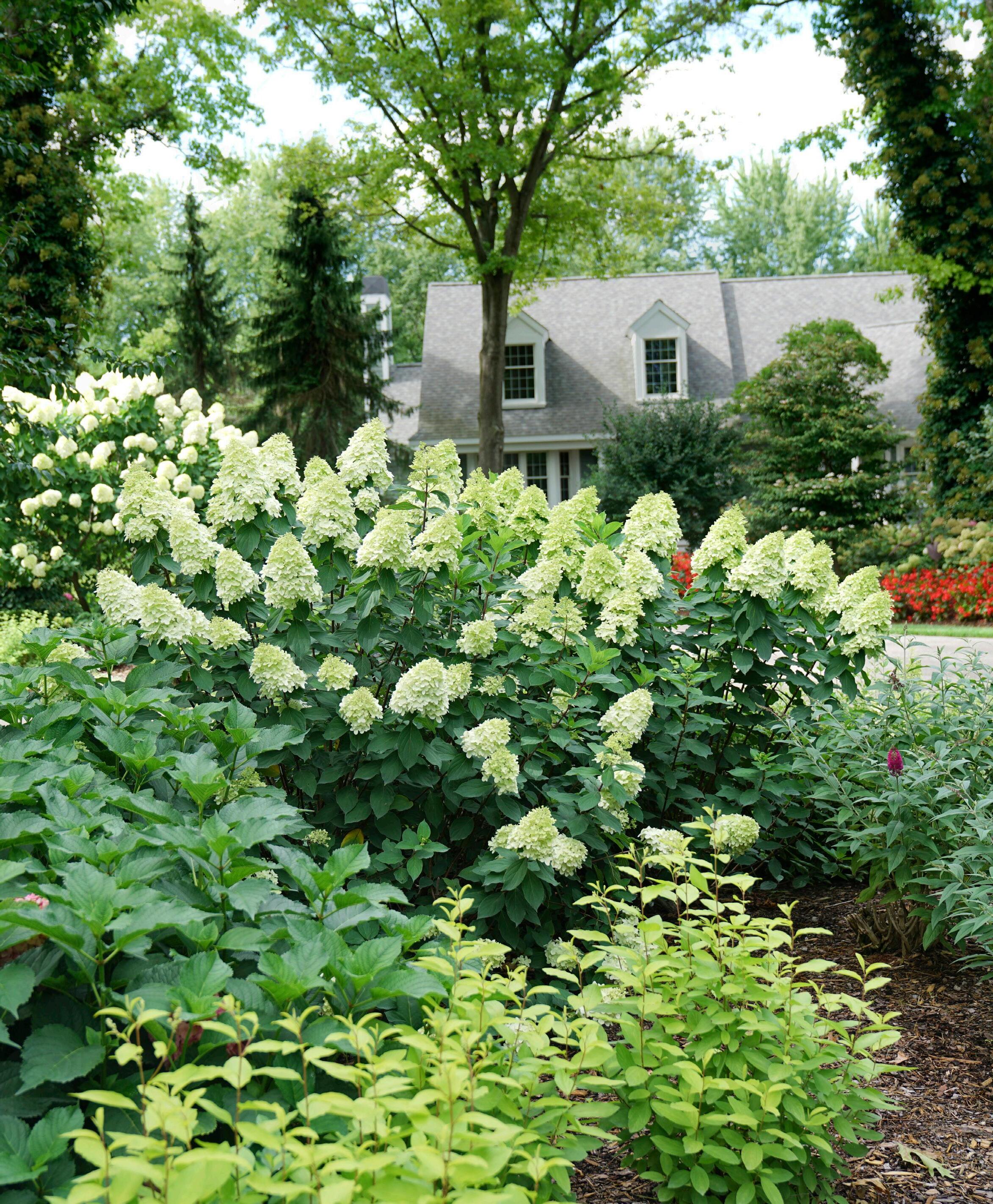
SPRING 2023 | 43 SUMMER USDA 3-8 4-6’ TALL + 4-5’ WIDE
FIND A WHOLESALER LIMELIGHT PRIME
Hydrangea paniculata ‘
PP#32,511;
Blooming
Stems
Vibrant
Available from Proven Winners® ColorChoice® growers www.provenwinners-shrubs.com
®
SMNHPPH’
CBRAF Long
| Strong
|
Color
What to watch for Prepare for late spring and summer turfgrass diseases



 by Alfredo Martinez, Professor and Extension Plant Pathologist, University of Georgia
by Alfredo Martinez, Professor and Extension Plant Pathologist, University of Georgia
Dollar spot can be still active. The dollar spot fungus (Sclerotinia homoeocarpa now named Clarireedia sp) can produce infections on warm season grass as soon as they start to green up. Dollar spot can continue to infect cool season grasses and can still be fully active at on late spring and /or early summer. Excessive moisture on turfgrass foliage and overcast humid days will promote dollar spot epidemics. Excessive thatch layers and compacted soil stresses is important at this time of the year. Monitoring fertility is an important first step to controlling dollar spot.
Chemical control for practitioners: A variety of fungicides are available to professional turfgrass managers for dollar spot control including fungicides in the classes of benzimidazoles, demethylation inhibitors (DMI), carboximides, dicarboximides, dithiocarbamates, nitriles and dinitro-aniline. Several biological fungicides are now labeled for dollar spot control. For a complete and updated list of fungicides available for dollar spot, visit http://extension.uga.edu/publications/detail.
cfm?number=SB28
44 | UAC MAGAZINE URBAN AG
Fig. 1. Dollar spot symptoms
Photos by Alfredo Martinez
Large patch in late spring.
Large patch is caused by the soilborne fungus Rhizoctonia solani AG 2-2 LP. The disease can infect all species of warm season turfgrasses, including St. Augustinegrass, zoysiagrass, centipede and bermudagrass. The disease is apparent during the spring and fall, when warm-season turfgrasses are entering or exiting their period of winter dormancy. R. solani occurs whenever the temperature of the thatch layer is between 50ºF (10ºC) and 70ºF (21ºC), and continuous moisture is available for at least 48 hours. Excessive moisture levels in the soil, thatch, and lower turf canopy encourage large patch development. Factors such as poor drainage, shade, restricted air movement, or excessive irrigation increase the severity of this disease. Rhizoctonia large patch is one of the most common and severe disease of warm season grasses across the state of Georgia. Circular patches of affected turf are easily observed, ranging in diameter from less than 3.3 ft. (1 m) up to 26.4 ft. (8 m). Leaves of recently infected turf, located at the periphery of the patch, may appear bright yellow and/or orange in color. Some patches may be perennial, recurring in the same location and expanding in diameter year after year. R. solani infection of warmseason grasses occurs on the leaf sheaths, where watersoaked, reddish-brown or black lesions are observed.
Foliar dieback from the leaf tip towards the base occurs as a direct result of these leaf sheath infections. The centers of the patches develop thin and sunken areas that may be invaded by weeds.
Management strategies include:
• Establishing a turfgrass species best adapted to your geographical area and situation;
• Making sure that areas are well-draining, as moisture levels in the thatch and soil is an essential aspect of large patch management;
• Preventing and/or alleviating soil compaction;
• Implementing a sound fertility program according to recommended guidelines for your particular turf species and an updated soil test;
• Cutting grass at the proper mowing height for that species;
• Emphasizing cultural and genetic control on home lawns, as few effective fungicides are available for the public to use for large patch management; and


• Applying fungicides in the following classes for commercial turf: carboxamides, benzimidazoles, carbamates, dicarboximides, DMI fungicides, dinitro anilines, nitriles, polyoxins, and Qo inhibitors. http://extension.uga.edu/publications/detail. html?number=C1088
Planning to renew your membership online?
Did you know that only your company's primary contact can make this transaction?
As a business-level member, your employees also are members of UAC. If you have employees who would like to be added to our system as additional contacts, just let us know. Those additional contacts will be able to log in as a member, edit their contact details, view member-only content and register for events at the member rate. However, they will not be able to edit or renew the company membership unless they use the email and password of the primary contact.
Need help with login? Call 706.750.0350 or email office@georgiauac.com.
SPRING 2023 | 45 URBAN AG
Fig. 2. Symptoms of Rhizoctonia Large Patch
Photos by Alfredo Martinez
Brown patch on tall fescue is caused by R. solani strain (strains AG 1 and AG 2-2IIIB) (Plant pathologists call “large patch” to R. solani infections on warm season grasses and “brown patch” to R. solani infecting cool season grasses) can cause a foliar blight, which results in necrotic leaves and circular brown patches up to 4-5 ft in diameter. High soil and leaf canopy humidity, and high temperatures increase disease severity. Higher than recommended rates of nitrogen in the spring promotes disease. Symptoms are more severe when night time temperatures are above 62-65º F that coincides with 10 hours of leaf wetness. Management options includes: avoid nitrogen application when the
disease is active, avoid infrequent irrigation and allow the foliage to dry, mow when grass is dry, ensure proper soil pH, thatch reduction, and improve soil drainage.
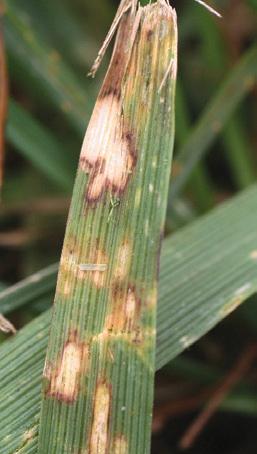


Several fungicides are available for each of the diseases described above. Consult the Georgia Pest Management Handbook (https://ent.uga.edu/extension/pestmanagement-handbook.html) or the Turfgrass Pest Control Recommendations for Professionals (www. georgiaturf.com) for proper fungicide selection and usage. Read the label and follow proper guidelines. For more information on Brown patch and Pythium visit https://extension.uga.edu/publications/detail. html?number=B1233#BrownPatch
Pythium blight on tall fescue.
Pythium has the potential to quickly cause significant damage to tall fescue. The disease starts as small spots, which initially appear dark and water-soaked. Affected turfgrass dies rapidly, collapses, and appears oily and matted. White, cottony mycelium may be evident early in the morning. The disease is driven by hot-wet weather, which correlates with an increased stress on the turf. Similar environmental and cultural factors that encourage brown patch also promote Pythium. Therefore, cultural practices for control of brown patch will also help to minimize Pythium blight development. A correct diagnosis is important because Pythium control requires specific fungicides. Several fungicides are available for each of the diseases described above. Consult the Georgia Pest Management Handbook (https://ent.uga. edu/extension/pest-management-handbook.html) or the Turfgrass Pest Control Recommendations for Professionals (www.georgiaturf.com) for proper fungicide selection and usage. Read the label and follow proper guidelines. https://extension.uga.edu/publications/detail. html?number=B1233#PythiumRootRot
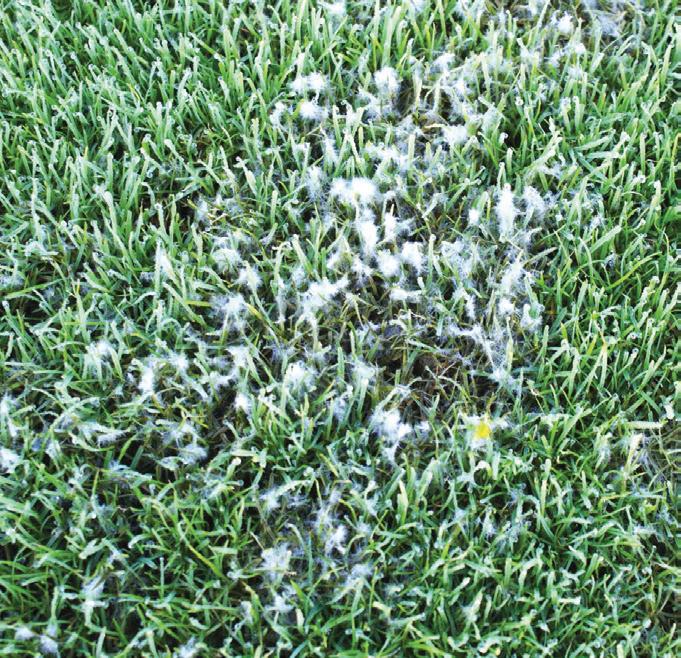
46 | UAC MAGAZINE URBAN AG
Fig 3. Brown patch on tall fescue
Photos by Alfredo Martinez
Fig. 4. Pythium blight on tall fescue
Photos by Alfredo Martinez
Test for and manage nematodes.


Nematodes are small round worms that are common in soils and aquatic environments. Most of the nematode species are considered as “free-living” meaning they forage for microorganisms in the soil and water, and some attack other nematodes. About 15% of described nematodes are plant parasites (PPN). Most plant pathogenic nematodes are 0.5 to 4 mm in length. Plant parasitic nematodes (PPN) feed through a retractable hollow or grooved spear (stylet). Plant parasitic nematodes can be grouped by their mode of feeding. Those that remain outside of the plant are called ectoparasites. Endoparasites enter into the plant tissue. Some endoparasites remain in one place and feed and others migrate through the tissues. PPNs can become a significant factor affecting the health, quality, production, and maintenance of warm and cool season turfgrass on landscapes, golf courses, sports field and sod production. Major PPNs frequently found associated with turfgrass in Georgia include lance (Hoplolaimus spp.), ring (Mesocriconema spp.), root-knot (Meloidogyne spp.), spiral (Helicotylenchus spp.) sting (Belonolaimus longicaudatus), stubby root (Trichodorus spp.) and stunt (Tylenchorhynchs spp.) nematodes. Nematodes injure turfgrass roots by either feeding on, or by burrowing through tissues. Depending on the host and the nematode involved, symptoms on roots include: inhibition of root elongation, swollen tips, galls, lesions, and shortened stubby roots. In most cases root symptoms are not obvious. Symptoms occurring aboveinclude patchy areas of wilting, thinning and decline occur where nematode populations are excessively high. Above-ground symptoms are of little value in diagnosing nematode problems in turf. An accurate assessment of the pathogenic potential of nematodes can only be determined by a nematode assay.

Management
Have a soil test done, send root zone soil sample to a nematology diagnostic lab to quantify and identify the nematode species. Negative nematode effects will only occur if soil population numbers exceed estimated damage thresholds levels. Fertilize if necessary and water appropriately to keep grass as vigorous as possible. Nutrient deficiencies and soil compaction can inhibit root development and increase turf sensitivity to nematode damage. There are several nematocides available including Divanem (abamectin), azaguard (azadirachtin), Nortic (Bacillus firmus), Nimitz (fluensulfone), Indemnify (fluopyram), MultiGuard protect (furfural), Econem (Pasteuria usagae), Neo-Tec (sesame oil). Check product labels as some of these nematicides have restrictions on what type of site they can be used on.
SPRING 2023 | 47 URBAN AG
Fig. 5. Nematode symptoms and nematode observed using a microscope
Photos by Alfredo Martinez
Looking for no-fuss evergreen options?
8 practical alternatives to boxwood shrubs
by Susan Martin for Proven Winners
Unfortunately, boxwood blight, a lethal disease caused by an easily spreadable fungus, has become prevalent in the U.S. since coming in from Europe a decade ago. Black spots on the leaves and stems, followed by defoliation are telltale signs of boxwood blight. There is no good treatment for it and once one of your boxwood shrubs has contracted it, the fungus can quickly spread to your other boxwoods.
Looking to replace boxwood shrubs with something more disease resistant? Here are eight substitutes that will give you a similar look without all the fuss.


Boxwood (Buxus) is one of the most widely planted evergreen shrubs in the world. Since it is adaptable to so many different growing conditions and is easy to maintain, people often plant boxwoods in great numbers to make tidy hedges and enjoy year-round interest.

There is some good news, however. Breeders are working diligently to develop and test varieties of boxwood that are resistant to the blight. Proven Winners’ North Star® and Sprinter® (shown left) boxwoods have been shown to have very good resistance to boxwood blight in trials.
Substitutes for boxwood
If you’d like to find an alternative to boxwood that is not susceptible to boxwood blight, check out the eight plants shown here. Some look so much like boxwood that you’ll be hard pressed to tell the difference. Others perform a similar function as a boxwood hedge but with a slightly different appearance that you may like even better.
Inkberry Holly
Gem Box® and Strongbox® Ilex glabra
The closest boxwood lookalike you’ll find is inkberry holly, specifically these two varieties that were developed expressly for this purpose. Inkberry holly has small, ovalshaped leaves that look more like a boxwood leaf than a traditional holly leaf that has spiny points. They are soft to the touch and won’t be scratchy when you walk by. Like boxwood, these evergreen plants can be sheared into balls, boxes and hedges.
48 | UAC MAGAZINE URBAN AG
Gem Box®
Strongbox®
Inkberry holly is native to coastal states from Maine to Texas and is hardy in zones 5-9. It grows a bit faster than boxwood but is not drought tolerant. It will be happiest in moist, acidic soil in sunny or partly shaded conditions. These varieties reach 2-3’ tall, with Gem Box having a slightly more rounded shape and Strongbox growing a bit wider than tall.
easier to grow than to pronounce! This dwarf evergreen shrub forms a mound of tiny, shiny dark green leaves on thin stems. If left unpruned, it will form a thick, mounded, evergreen mat. With a little shearing after the new growth flushes out in spring, it is easily shaped into a traditional boxwood-like ball, square or hedge.
Juke Box pyracomeles grows 1-3’ tall and wide in full sun to part shade conditions in zones 7-9. Though it has survived the winter for several years in zone 6, it typically sustains some winter damage to its evergreen foliage which is why we recommend it for areas further South. Any well-drained soil and average moisture will keep this plant happy.
For a shorter, brightly colored hedge around your patio, along your front pathway, or in containers, choose Brass Buckle Japanese holly. Its leaves are similar to inkberry holly but are slightly smaller and stay bright yellow all season long. This plant thrives in part shade conditions but even when grown in full sun, its lightly colored foliage is burn-resistant.

This is one of the most dwarf Japanese hollies you’ll find, maturing to just 12-18” tall. That makes it ideal for use as a low growing border in front of a bank of roses or other mid-sized shrubs and perennials in the landscape. Like boxwood, it is easy to shear into a formal hedge. Hardy in zones 6-8.
Globe Arborvitae
Tater Tot® Thuja occidentalis
By now, you are starting to see the theme here. There are lots of densely rounded, boxwood-like shrubs you can substitute for Buxus in your landscape without the worry of boxwood blight. Next up is this super cute evergreen globe arborvitae that’s worth growing for its name alone.

Tater Tot arborvitae has a shape much like its namesake, forming a slightly taller than wide mound of dark green, aromatic, fan-shaped leaves. Very little to no pruning at all is needed to achieve the look you see here.
If your goal is to create a tighter hedge, space the plants about one foot apart. Your Tater Tot hedge will grow up to 2’ tall unless you prefer to keep it slightly shorter by lightly shearing it back in spring. Full sun to part shade and well-drained soil are what this shrub needs to thrive in zones 3-7.
Juke Box® Pyracomeles
Chances are you’ve never heard of a shrub named Pyracomeles. It may not have an easy common name to remember like boxwood, but we promise that it is much

SPRING 2023 | 49 URBAN AG
Japanese Holly
Brass Buckle® Ilex crenata
Pyracomeles
Globe Arborvitae
Anna’s Magic Ball® Thuja occidentalis
If you love the look of Tater Tot arborvitae but need something a little smaller, try Anna’s Magic Ball. It’s similar in size and shape to a bright yellow bowling ball, growing just 10-15” tall and wide. Those shown in the picture above are nearly full grown, so you can get an idea of how they could work for you as a short, whimsical, evergreen hedge. Try it in full sun where its lightly colored foliage won’t burn, or in a partly shaded location that sees 4-6 hours of sun each day.

Like Tater Tot arborvitae, this plant is easy to grow in any well-drained soil in zones 3-7. This species of arborvitae is native to much of the eastern U.S. and Canada. Very little to no pruning is needed to keep its densely spherical shape.

easygoing nature. If your shade also comes with deer, however, you may need to protect them with animal repellent or choose an alternative shrub. Yews also grow well in full sun conditions.
Yews mature slowly but are very long-lived, which makes them ideal for planting as a hedge. They are easy to shear into just about any shape you can dream up, from a classic boxy hedge to the whimsical characters you’ll see yews carved into on the great lawn of the worldrenowned Longwood Gardens.
Stonehenge Dark Druid forms a 2-3’ tall by 3’ wide mound of dark green, soft needlelike foliage. It retains its color beautifully through all four seasons and is very cold hardy, thriving in zones 4-7.
Yew
Stonehenge Dark Druid® Taxus x media
If you are looking to plant a hedge in partial to full shade, you’ll find this is the most shade tolerant plant of the eight described in this article. It’s one of the primary reasons people choose to grow yews, coupled with their
Mirror Bush
Waxwing™ Lime Coprosma repens

Here’s a fun boxwood alternative for our friends in the South. This zone 9-11 hardy evergreen shrub is nicknamed “mirror bush” for its extremely glossy foliage that reflects the glistening summer sun. Waxwing Lime’s leaves are a swirling mix of yellow, lime green and mahogany purple tones. Varieties with predominantly gold and orange foliage are available, too.
This shrub typically grows wider than tall, standing 1 to 2 ½’ and spreading up to 3’. It is easy to shear like boxwood into a tight, low hedge or bed edging. You could also choose to let it grow into its natural form and plant it amongst your flowers in garden beds and containers. Coprosma thrives in sunny to partly sunny spaces with average soil. You may also appreciate that it is deer resistant.
50 | UAC MAGAZINE URBAN AG
Reblooming Azalea
Perfecto Mundo® Double Pink Rhododendron
This amazing azalea does something your boxwood hedge could never do – it blooms! Gorgeous soft pink, double flowers adorn this shrub in the springtime. After taking a bit of a rest, it blooms again from midsummer to frost. Its bright green, evergreen leaves are similar in shape to boxwood and the plant typically grows 2-3’ tall and wide. Perfecto Mundo azaleas come in more colors, too.
These reblooming azaleas bloom on both old and new wood, so the best time to prune them is immediately after its spring flowers fade. Trimming the plants lightly encourages new growth, and with new growth comes even more flowers.
This azalea is hardy to zone 6b and is better suited to milder coastal areas of zone 6b than harsher Midwestern sites. If you wish to plant it in zone 6b, choose a sheltered location in sun or part shade and mulch around its roots for added protection

Visit the Proven Winners website to learn more: provenwinners.com/learn_articles

SPRING 2023 | 51 URBAN AG
Cer tiied tur fgrass available in Mega-rolls, 30” rolls or slab pallets. Call Darren at 770-530-5078
Controlling bittercress Study focuses on mulch and herbicides

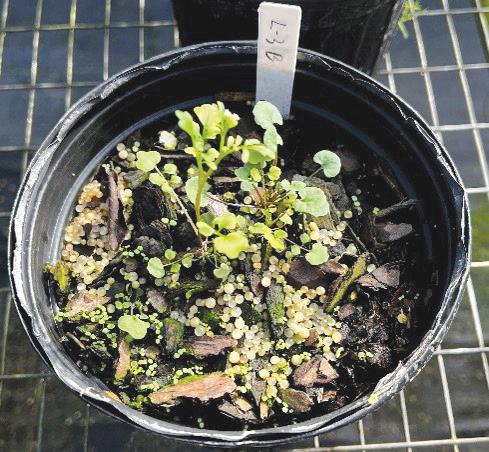 by Ping Yu, University of Georgia Department of Horticulture and Chris Marble, University of Florida Department of Environmental Horticulture
by Ping Yu, University of Georgia Department of Horticulture and Chris Marble, University of Florida Department of Environmental Horticulture
Bittercress
(Cardamine spp.) is a cool-season annual weed but grows year-round in nursery and greenhouse production conditions.
Bittercress belongs to Brassicaceae (mustard family) and is known as Lamb’s cress, spring cress, wood cress, and flick weed. With more than 200 species worldwide, bittercress weeds can be found on every continent except Antarctica. It is one of the most common and difficult weed species in container nurseries because it reproduces rapidly, transports easily, and may harbor pests.
Bittercress is persistent in shaded, moist areas but is most problematic in the fall through the spring during cooler temperatures, which are more favorable for their germination and growth. One bittercress plant can produce five thousand seeds that have no dormancy requirement and can germinate quickly. Upon germination, bittercress can reach maturity and begin flowering and seeding in as little as five weeks under favorable conditions.
Herbicide control
Many commonly used herbicides control bittercress effectively in containers. Preemergence herbicide such as isoxaben (Gallery®), prodiamine (Barricade®), flumioxazin (Broadstar®), indaziflam (Marengo G®), dithiopyr (Dimension®), oxyfluorfen + pendimethalin (OH2®), isoxaben + trifluralin (Snapshot TG®), and post emergence herbicide such as glyphosate (RoundUp®), glufosinate (Finale®), diquat (Reward®), and pelargonic
acid (Scythe®) and among others provide over 90% control for bittercress in many instances. The container needs to be weed free before herbicide application to have an effective herbicide control. However, bittercress can still be hard to control as it produces many seeds, germinates fast and grows year-round.
Alternative control
The wide use of herbicides can create problems such as herbicide-resistant weeds, environmental concerns, and economic losses. Thus, nonchemical (mainly mulches) and integrated weed control method (herbicide + mulches) has been evaluated to provide alternative ways to control bittercress.
Some of the most widely evaluated mulch materials have included pine bark, rice hulls, Douglas fir bark, coconut coir, newspaper pellets, and wastepaper. Pine bark mini nuggets is suggested to be applied at 3 inches to achieve effective control while rice hulls are recommended to be applied at a depth of 0.5 to 1 inch.
Herbicide and mulch study

To compare the effects of different herbicides and mulch materials on bittercress control, we conducted a study in a greenhouse. We filled pots with pine bark-based soil and applied rice hull and pine bark mini nuggets at 1 inch on the soil surface. Two types of preemergence herbicides isoxaben (Gallery SC) and prodiamine (Barricade 4L) were applied at 1 (or 31fl.oz/A-100 gallons/acre) and 1.5 lb/acre a.i. (or 41fl.oz/A-100 gallons/acre), respectively. Five days after the herbicides have been applied, we sowed 25 bittercress seeds on the surface of each pot and then measured bittercress emergence rates, seed numbers, and shoot dry weight.

52 | UAC MAGAZINE URBAN AG
Young (top) and matured (bottom) bittercress grown in a container in greenhouse.
Container-grown bittercress in a nursery.
Study results
Once weeds reach the reproductive stage as was noted at 8 weeks after sowing in this study, emergence then may sharply increase when new seeds are introduced on the potting soil surface. Rice hulls provided better control of bittercress compared to both pine bark and the use of either herbicide alone or in combination with mulch materials.
Overall, results from this experiment indicate that application of pine bark or rice hulls mulch provide a
definite weed control benefit. For seeds introduced on top of the mulch surface as would be typical in a nursery environment, rice hulls outperformed pine bark when both were applied at a 1-inch depth.
However, growers considering use of mulch should consider cost, stability in the container (breakdown over time and ability to stay in the container during severe weather events), and availability in addition to weed control benefits.

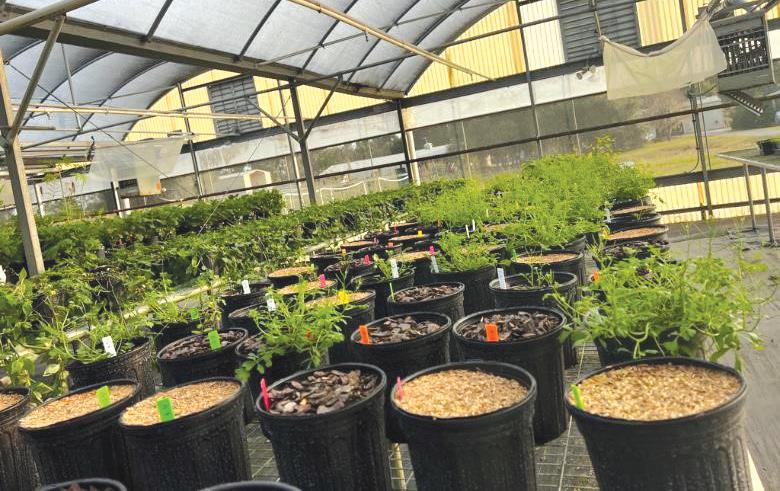

SPRING 2023 | 53 URBAN AG
An overview of bittercress grown in different treatments after two (Left) and 11 (Right) weeks of sowing.
Take-home message
Bittercress root balls from different treatments after 11 weeks of sowing. Herbicide + mulch outperformed using herbicide alone.
Applying rice hull at 1 inch alone is the best way to control bittercress among all other treatments.
Using mulch (both rice hull and pine bark nuggets at 1 inch) alone and herbicide alone can both control bittercress.

When using herbicide alone, Barricade performed better than Gallery in this experiment.

When dealing with bittercress, act early, remove bittercress before it matures.
When considering using mulch, other factors such as costs, weather condition, and container stability also need to be considered.
54 | UAC MAGAZINE URBAN AG
Bittercress (25 seeds per container) treated with mulch (rice hull and pine bark), herbicides (Gallery® and Barricade®) and their combinations in trade gallon container for 11 weeks after sowing. The control is applied with water.
6.
1. 2. 3. 4. 5.

The color white and the moonlit garden
Enchanting, magical and full of memories
by Norman Winter, Horticulturist, Author and Speaker
Each year, my color design guru son James orders plants for use at his clients’ homes - from those that look like historic cottages to palatial garden estates, those on the waterfront to those considered mountainous. The one color guaranteed to be in heavy use is white. When spring arrives every year with all of its glorious colors -- purples, pinks, yellows and reds, the color guaranteed to catch your eye every time is white. Of course, a scientist would most likely say white is not a color because it absorbs no other color or wavelength and is pure, but that purity is what grabs you.
Pure and unspoiled goes hand-in-hand with the bride wearing a white dress, or the nurse wearing a white uniform. It’s like the morning you wake and see the pure white snow on the ground that is still untouched.
Mother Nature does this in the spring forest. The dogwoods seem to glow with their blooms, attracting our attention to the glistening, reflective bracts in an otherwise simple forest of green.
Planning and precision
White flowers, like last year’s new Soprano impatiens, not only give definition to those shadier areas of the landscape but offer a sense of cleanliness and purity as well. They also give a feeling of planning and precision. In other words, the gardener knew what he or she was doing by carefully planting white.
When possible, use white bedding plants like Supertunia Vista Silverberry, Supertunia Vista Snowdrift or Supertunia Mini Vista White at the front of the border, along sidewalks or trails to define where the walkway begins. This makes the nighttime stroll in the garden come alive.


Out in the landscape proper the hydrangeas rule like royalty whether they be varieties of the native Oakleaf (Hydrangea quercifolia), the native smooth hydrangea (Hydrangea arborescens) or the Pee Gees (Hydrangea paniculata). Could there be a reason they named it Limelight?
No matter the area of the landscape, porch, patio and deck, include the color white for its reflective nature. Here Superbena Whiteout is paired with Superbena Sparkling Rose verbena.
Use
the
to allow its reflective capacities to give definition at night. Here Diamond Snow euphorbia is used along the outside border with red begonias.
or
In the landscape, hydrangeas rule like royalty varieties of native oakleaf like Gatsby Gal, Gatsby Moon and are always guaranteed to catch your attention even on a moonlit night.
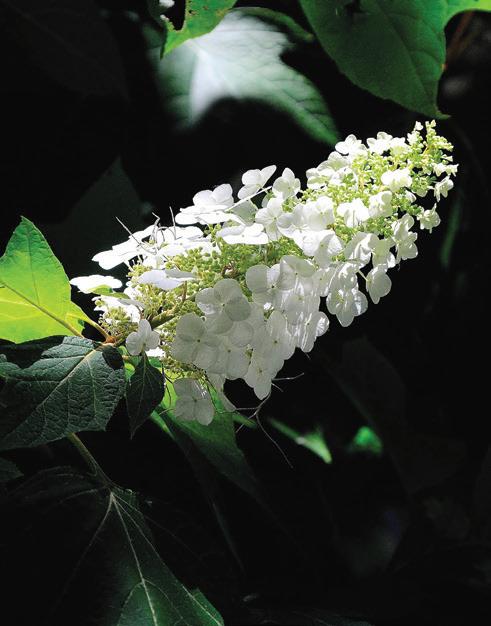
56 | UAC MAGAZINE URBAN AG
white flowers along
edge, border,
pathway
White is the last color to disappear as the sun sets in the evening. If it is a moonlight night white blooms will reflect this light all night.
Give a vertical dimension
with climbers and tumblers
Use flowering vines like the Proven Winners new Thunbergia, Coconut A-Peel, or the tropical Bombshell White mandevilla to add nighttime interest. They give a vertical element by climbing a Victorian-style tower or trellis. Last year’s new Fairytrail Bride, the first cascading hydrangea, can turn an urn into a living piece of statuary in the moonlit garden.
While ‘The Garden Guy’ loves hot orange, red and salmon, if you walked onto my patio at night the Superbena Whiteout verbenas would be seen tumbling over the rims of containers and cascading over the rock wall in the distance. This is a verbena for all time, offering vigor and large flowers glistening in the moonlight.
Making the moonlit garden magical
The moonlit garden can be incredibly magical with the addition of shrubs with white fragrant flowers. This will be the place where childhood memories are made.
Proven Winners has introduced the Illuminati series of fragrant Mock Oranges which will have three varieties with the addition of the new Illuminati Sparks in 2023. Then there are the native Clethera or summersweet, like Vanilla Spice and Sugartina Crystalina. The mere mention of their name says olfactory experience. The shrub that everyone has been talking about however, is Fizzy Mizzy, a compact fragrant native Virginia sweetspire that made its debut in 2022.
The Moonlit Garden is enchanting and magical, it just takes a little planning and the prerequisite is the color white. Every aspect of the landscape can have white included. Here is hoping you will give it a try.
About the author
Norman Winter is an author and speaker on horticultural topics.

Follow him on Facebook for more photos and garden inspiration: Norman Winter The Garden Guy
In the summer, landscapes all across the county are showing out with Hydrangea paniculata varieties like Limelight and this new Limelight
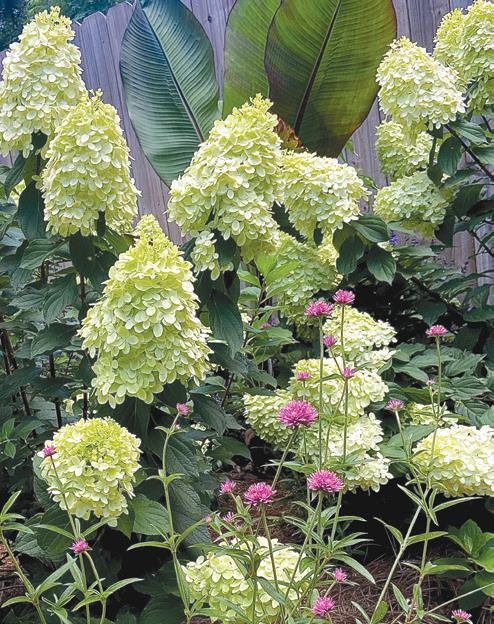
Prime that offers showy visibility all day and night.
Varieties of native Virginia Sweetspire like Little Henry, Scentlandia and the new Fizzy Mizzy not only offer white during the day and night but have an incredible fragrance that all will remember.
No shrub offers more fragrance and beauty than the summersweet or clethra, varieties with names like Vanilla Spice and Sugartina Crystalina say it all, promising sweet memories.


SPRING 2023 | 57 URBAN AG


58 | Directory of advertisers Company/Website: ................. Page # Atlanta Best Media 32 atlantabestmedia.com Frank A Smith Nurseries ......................... 27 fasnurseries.com GA Certified Landscape Professional ....... 29 ugaurbanag.com/certification Greene County Fertilizer Company .......... 15 greenecountyfert.com Legacy Turf Farms .................................. 59 legacyturffarms.com NG Turf 60 ngturf.com Power Equipment Distributors 2 powereqp.com Progressive Turf Equipment .................... 13 progressiveturfequip.com Proven Winners ..................................... 43 provenwinners-shrubs.com Snellings Walters ................................... 33 snellingswalters.com Sod Solutions .................................... 7, 55 sodsolutions.com Sunbelt Turf 51 sunbeltturffarms.com Super-Sod ............................................. 3 supersod.com WORKERS COMP INSURANCE EMPLOYEE BENEFITS PROPERTY AUTO
#1 IN NTEP!
#1 IN TURF QUALITY (TIED)
#1 IN SPRING GREEN UP
#1 IN WINTER SURVIVABILITY
PLUS, HIGH RATINGS IN:
• Leaf texture
• Color
• Density
• Vigor
• Drought Tolerance
At 17 locations over 5 years through the National Turfgrass Evaluation Program (NTEP), Tahoma 31 is the leader in key metrics that matter to turfgrass managers in real-world applications. Visit ntep.org to see the full results.
Developed by the turfgrass breeding experts at Oklahoma State University, Tahoma 31 Bermudagrass is the right choice for sports fields, golf courses, and lawns
LEGACY TURF FARMS

850 Indian Mounds Road Cartersville, Georgia 30120 770-607-0491
sales@legacyturffarms com

SPRING 2023 | 59
RESERVE YOUR TAHOMA 31 SOD TODAY!






60 | UAC MAGAZINE Farm Fresh Sod • ngturf.com • 770-431-1347 PARTNERS YOUR PREMIUM SOD Our Certified Turfgrass Professionals are ready with sod solutions for every job. CONVENIENT DELIVERY INCLUDING MONDAY AM CUT TO ORDER & HARVESTED FRESH DAILY! Visit NGTURF.COM Our Pro Online Store available 24/7. Call 770-431-1343 for more Farm, Fresh Sod information *See Website for Details 10+ VARIETIES INCLUDING: FESCUE

























































 by Shimat V. Joseph, Associate Professor, University of Georgia Department of Entomology
by Shimat V. Joseph, Associate Professor, University of Georgia Department of Entomology



































 by Brian Sulka, Professional EOS Implementer® at EOS Worldwide
by Brian Sulka, Professional EOS Implementer® at EOS Worldwide











































 by Alfredo Martinez, Professor and Extension Plant Pathologist, University of Georgia
by Alfredo Martinez, Professor and Extension Plant Pathologist, University of Georgia





















 by Ping Yu, University of Georgia Department of Horticulture and Chris Marble, University of Florida Department of Environmental Horticulture
by Ping Yu, University of Georgia Department of Horticulture and Chris Marble, University of Florida Department of Environmental Horticulture
























